High-Performance Foils
Shaping better centerboards and rudders
From Issue July 2020
W hile it’s generally accepted that the right sails and sail trim will determine how close you can sail to the apparent wind, a sailboat’s progress to windward also depends on the lift and drag generated by the centerboard and rudder. How much difference does proper foil shape make over a simple rounded leading edge and tapered trailing edge, anyway? Foils operating in fluids, whether air or water, are a well-studied topic. C.A. Marchaj, in his book, Sailing Theory and Practice , discusses the theory and gives the results of actual tests of differences in foil planform (side view), cross-section shape, size, and aspect ratio (AR – length to width). Lacking other constraints, an ideal centerboard, daggerboard, or rudder blade should have a reasonably high AR (greater than 2) planform with a streamlined cross-section that has a parabolic leading edge and a thickness of somewhere near 10 percent of the chord width (the distance from leading edge to trailing edge). A thickness of 8 percent produces less drag but stalls sooner; 12 percent has a higher stall angle but produces more drag.
Exactly where the point of maximum thickness should be located is a matter of some debate. Marchaj suggests it should be at 50 percent of the chord width, halfway between the leading edge and trailing edge, but provides no data to back that up. Other sources suggest that the NACA (National Advisory Committee on Aeronautics) symmetric foil sections, originally developed during aircraft research, are actually a good fit for boat foils operating at low speeds in water. A NACA 0010 foil, for example, has a maximum thickness of 10 percent of the width of the foil, located at 30 percent from the leading edge.
Of course, there are many practical reasons why not all keels, centerboards, and rudders have high AR planforms, but the cross section for a foil of any planform should be streamlined. My personal experience of doing it wrong on one boat, and getting it right on another boat, has convinced me that the NACA sections and guidelines above provide good performance.
HORNPIPE, my first sail-and-oar boat, was an 18’ Kurylko Alaska with a standing-lug ketch rig, and sailed well enough to windward in flat water, but lost 10 to 15 degrees of pointing ability as soon as the water got choppy. I knew it wasn’t poor sail trim. Eventually I got looking at the daggerboard and analyzed it. It was only about 2.5 percent of the sail area and its thickness was only about 6 percent of the chord width, neither big enough or thick enough in my view, and in rough water it lost laminar flow and lift. When I designed my 18′ lug-yawl cruiser, FIRE-DRAKE, I gave it a thicker centerboard with a greater fraction of the sail area, about 4 percent. I also gave it a straight quarter chord line (think of the shape of the wing of a Spitfire aircraft) and a moderately high aspect ratio of about 3:1 for the planform area. To get the daggerboard foil shaped accurately and quickly I opted to have it cut on a computer numerical control (CNC) machine. All that was left for me to do was sand, seal and paint, and make an epoxy-lined hole for the pivot pin.
The results have been what I had hoped for. FIRE-DRAKE sails quite well to windward and maintains its performance in rough water. I sailed in the company of a similar boat—with the same length and beam, the same weight, and the same sail plan—along the south half of the Inside Passage, and that boat’s centerboard was shaped by eye. When sailing to windward, FIRE-DRAKE would consistently point higher and walk away in speed. My centerboard even let me continue sailing to windward when my partner gave up and took to the oars.
Although I had the daggerboard shaped with a CNC router, it is possible to shape a high aspect ratio, fully streamlined foil in the home shop. I’ll walk you through my second project, a kick-up rudder blade that I made at home to replace the original one I built for FIRE-DRAKE. I settled on a planform that is one-quarter of an ellipse with an elliptical leading edge and a straight trailing edge. (The shape would move the center of lateral resistance of the boat aft a few inches, and is intended to lighten the weather helm I’d experienced with the original rubber blade.) I drew the new blade with an aspect ratio of 2.5:1, with a length of 30″ (762 mm) and a maximum chord width of 12″ (305 mm), which would increase the lift and reduce the tip vortex drag.
To draw the planform shape of the quarter ellipse you can use an online graphing tool such as Desmos for a full ellipse. If you center the ellipse at zero, you can drag the two axes out until you get the aspect ratio you want. Since the graph has a grid in the background, you can then print out a screen capture of a quarter of the resulting ellipse and scale up the printed image to the actual dimensions required. If you are comfortable with computers, you can download and run Freeship (available for Windows only) which has a “keel and rudder wizard” that accurately generates several different planforms.
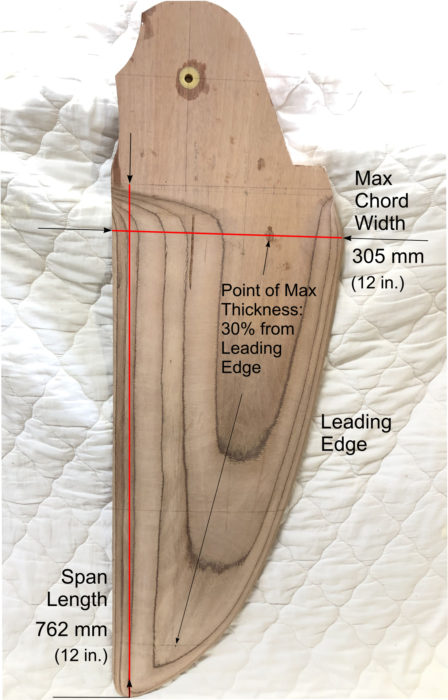
The new rudder blade for FIRE-DRAKE has a quarter-ellipse planform. The plywood’s glue lines show the contours that help with shaping the foil.
Obtaining the cross-section profile of a chord of a given width is best left to a computer. For any of the NACA foils, like the 0010 foil I mentioned above, Competition Composites Inc . (CCI) has a very simple and handy calculator . You need enter only the chord width and the maximum thickness and it will generate a table of X-Y coordinates that you can copy and print out. They’ll be your offsets for drawing a pattern for the foil cross-section. If you intend to sheathe your foil with ’glass and epoxy, for example, you can also enter the skin thickness and it will calculate the coordinates for the plywood core.
Now, here’s the tricky bit. If you have a rectangular foil planform, you only have one chord width and therefore one section profile for the entire length of the foil. However, if you have any other planform (e.g., half-ellipse, quarter-ellipse, trapezoidal, straight-chord-quarter-line, etc.), the thickness, which will be one-tenth of the chord width, changes along the length of the foil because the chord width changes.
I used the CCI calculator to generate profile coordinates for three different points along the length of the rudder blade: at the root, at about two-thirds of the way along and at about 90 percent of the way to the end. I chose those points because the chord width for my quarter ellipse planform doesn’t change much for the first half of its length, but it changes more quickly toward the tip. The idea is to shape the foil to these profiles at these points and then taper the foil evenly between them. You can lay out your foil plan directly on to the ply or you can use something thin, like doorskin, to make and fine-tune a template, which is what I did.
I made a blank for my rudder by gluing layers of marine ply with epoxy to the required 1″ thickness. I have found that the plywood, in spite of its cross-grain plies, has sufficient strength for the size of small-boat foils that I have built (though the cross-grain would weaken a long thin foil). Plywood does not warp and has the added advantage over solid wood in that the plies create a kind of contour map that give you graphic visual feedback as to the evenness of your surface once you start shaping the foil. You can make a foil with solid wood or even foam plus a ’glass-and-epoxy skin, but without the plywood laminates as guides, you would have to make more section profile templates to ensure a smooth and accurate shape.
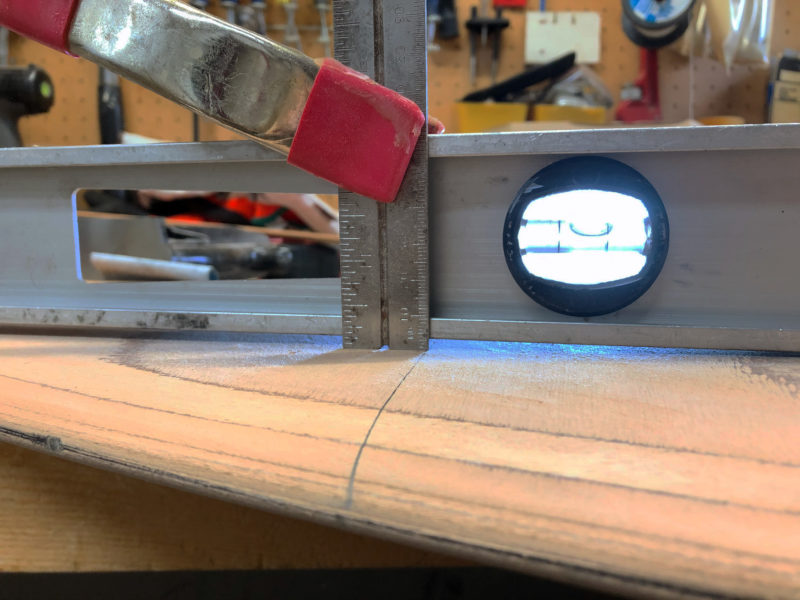
Clamping a 4′ level to the flat part of the rudder blade provides a reference line to gauge how much wood to remove to achieve the foil’s taper.
The next step is to taper the thickness of the laminated foil blank along its full length. Knowing the required thickness at your chosen points, you can draw a pattern for the curve of the taper and half the thickness of the blade stock and measure how much wood you have to remove at each point. I clamped my 4′ aluminum I-beam level to the flat part of the rudder blade above the shaped part, and used a ruler to measure the depth I had to cut to. To remove the wood for this part of the project, I used my #4 Stanley plane. While I have a power hand planer, I didn’t trust myself with it to not take too much off too quickly.
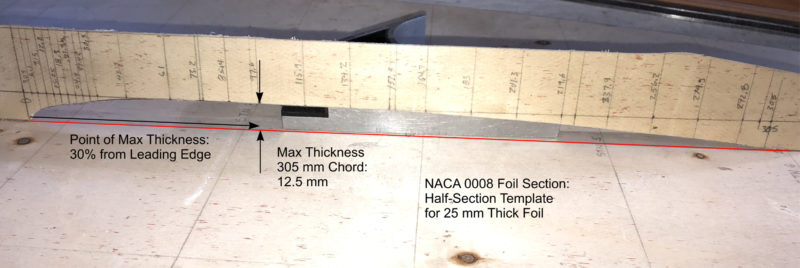
The female half-section template for a given chord for a foil gets its shape from the X-Y coordinates generated by a foil calculator.
I made three female half-section profile templates, one for each of the three points noted above, by plotting out the generated X-Y coordinates on pieces of doorskin and carefully cutting them out. One thing to note is that the CCI calculator generates a profile that has a trailing edge of zero thickness. Obviously, this is not practical to build in wood, and a knife edge is not that critical anyway. I adjusted the trailing edges so that the finished edge would end up about 1/3″ (4mm) thick.
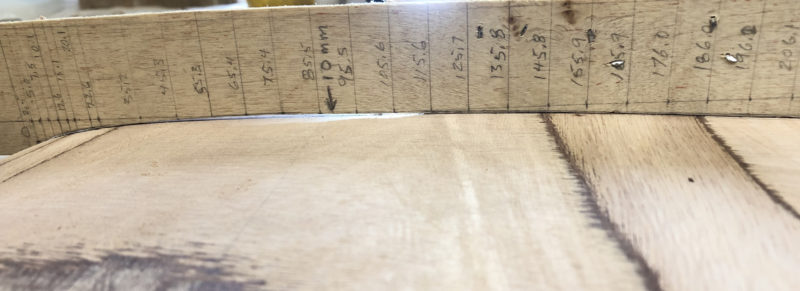
Applying the template to the foil in the works shows the high and low spots as the shaping continues.
Next, I used the profile templates to shape the foil at my three chosen points. I shaped the plywood with a Shinto rasp , regular rasps, and coarse sandpaper. It’s a process of taking some wood off, placing the template, and repeating until you get the section of wood shaped to the templates. Once that is done, I could go to work taking down the wood between the sections, using the ply layers as a guide. I used my block plane, Shinto rasp, and sandpaper for this task. I eyeballed a smooth transition around the tip from the leading edge to the trailing edge.
I sealed the surface of the shaped foil with a couple of coats of epoxy to provide a smooth, hard surface to accept a finish coat of marine epoxy enamel.
Alex Zimmerman is a semi-retired mechanical technologist and former executive. His first boat was an abandoned Chestnut canoe that he fixed up as a teenager and paddled on the waterways of eastern Manitoba and northwestern Ontario. He started his professional career as a maritime engineer in the Canadian Navy, and that triggered his interest in sailing. He didn’t get back into boatbuilding until he moved back to Vancouver Island in the ’90s, where he built a number of sea kayaks that he used to explore the coast. He built his first sail-and-oar boat in the early 2000s and completed his most recent one in 2016. He says he can stop building boats anytime. He is the author of the recently published book, Becoming Coastal .
For further reading on the pros and cons of the variables in foil design, Competition Composites (CCI) has a good discussion . For those of you who want to go into the math, Paul Zander has a good presentation from nearly 20 years ago, and also, for those inclined that way, an updated discussion with a lot more math.
You can share your tips and tricks of the trade with other Small Boats Magazine readers by sending us an email .
Share this article

Join The Conversation
We welcome your comments about this article. If you’d like to include a photo or a video with your comment, please email the file or link.
Comments (17)
Is there someone who can craft a good rudder for my boat? I have not the time or the skills to do such. Have a 15′ Delaware Ducker. Love the boat but the rudder is (I think) a disaster. Hardly brings the boat around and doesn’t help much to windward. Flat plywood barn door out of 3/8″ ply with no shape other than outline that barely gets 2″ – 3″ into the water. If it could be a kick-up so much the better. I do a lot of shallow, sand-bottom sailing. Thank you for any help.
I know about the ducker and a foil shaped rudder will help a lot. Some of the modern ones built in glass and cold molded have been fitted with modern dinghy rudders and foil shaped daggerboards. They tack more like a dinghy than like my traditional one where I have to sail it around like a larger boat.
Most any small boat builder in your area should be able to build you a rudder. Lines for a kick up would be a nuisance. I don’t bother with them on a larger boat, just use a pivot bolt with tension. Means I have to shove it down.
You might want to look at the system that Mike Storer has developed for his goat island skiff, a straight foil, easier to shape.
Alex has done a great idea showing us how to work these out using hand tools. We used to do it in my dinghy sailing days by drawing a 30 % line. Make a bunch of parabola templates and hack away. For really long narrow boards before the days of carbon we used to use 5/4 stair tread fir.
Interesting article. When I built my Oughtred JII Yawl eighteen years ago, I did some research on appropriate foil profiles for the centerboard and rudder. It’s a long time ago now, so I don’t remember the exact profiles I chose, but I do believe I picked NACA 0010 for the CB. I picked another profile for the rudder, one that had a steeper stall angle, on the theory that with typical weather helm the rudder meets the flow at a steeper angle than the CB. I really don’t know how valid my theory is. I have no experimental evidence to back it up. Any thoughts?
Andrew, that seems to make sense although I haven’t seen any research to back that up.
Hi Andrew, I remember seeing your beautiful JII; but did not ask about the foils! I wonder how NACA 0010 compares with my approximate foil shape, inspired mainly by guesswork. Are these profiles available? By the way, I do not like plywood foils; CBs break. Friends near here lost their fine old rebuilt Wayfarer; were in danger themselves, when they capsized and the plywood board broke. Too near a rugged lee shore. A class racing boat, by a particular builder – all their plywood centerboards broke.
Iain, I don’t know what your standard foil shape looks like, but a NACA 0010 has a maximum thickness of 10% of the chord distance, occurring at 30% of the distance back from the leading edge. Marchaj believes that the maximum thickness should occur at about 50% of the distance back from the leading edge. Other designers agree, I think. If I understand him correctly, John Welsford uses a foil section that is closer to 50% distance, but I am not sure what thickness of foils he favors or what the exact foil shape is. You can see the shape, and all the requisite numbers for extracting an X-Y plot to reproduce them, for a whole bunch of different foil types, on the Airfoil Tools site. As for plywood foils, I understand your concern. Half the plies are oriented in the wrong direction and don’t provide much in the way of resisting sideways bending moments. However, it has been my experience that this is not a major concern if the foil is thick enough and not too long. The centerboard foil on my latest boat, for example, is ply, but is nearly 2″ (50 mm) at maximum thickness. It’s got over 1,000 nautical miles in four years under the keel by now, including a couple of practice capsizes, with no issues so far.
I don’t know what a standard Wayfarer foil looks like. Is it long and thin?
Very interesting article. I am just in the process of building a Lillistone Flint and have no experience building or knowledge of foil design and performance. I calculated the various ratios and percentages. The AR as per the plans is 2.43, so that looks good. The thickness however is only 4% of chord width. Area of the dagger board is 3.5% of sail area, so probably OK there too. Lillistone does state in the plans that the board can be made thicker if preferred so I think I may do that as 4% is a pretty big departure from the 8 – 10% of the chord width suggested. Any comments? The Flint was featured in this mag a few issues ago.
David, both my experience and authorities who design for a living and/or who have tested these things would suggest that 4% is rather too thin for good lift. I suspect that you might find it works reasonably well in dead flat water but you would lose lift and pointing ability as the water gets more turbulent. If it was me, and I hadn’t yet built the foil and its case, I’d go for one that was at least 10% and maybe even 12%. The additional thickness would also be more robust should you need to stand on it to flip the boat over if you capsize.
Thanks so much for taking the time to reply, Alex. I have decided to use some salvaged King William (King Billy here in Tasmania) pine that was salvaged. I thicknessed it to clean it up a bit and reckon I will eventually get 20 – 22 mm out of it. I plan to laminate 10 pieces into a 304mm board. Hopefully I will get a good result.
Hi David, It highly depends where you sail and how you sail. I have one older (1975) 420er dinghy for fun and local competitions with foiled board and rudder. But then I have 21″ German Jollenkreuzer veteran from 1952 which has both from 1/4″ steel plate, and it works fine. I sail that for pleasure on lakes. It would definitely be more performant (and point better) with both foiled, but I’m surprised how well it performs in its nearly ’70s (comparing to modern GRP boats with foiled boards).
For your job, I would probably stick to the plans. The rudder in this case is more important and can be somehow easily modified (foil). The centerboard I would keep the same, not only to conform the centerboard box (which would need to be sized), but also the overall design. Finally the most important here is what is your building and designing experience, because the worst thing is when something is incorrectly designed and then improperly built (the simple rounded plywood then may work better).
Anyway, I’m also thankful for this article. It reminds me my childhood when I built airplane models and used exactly the same methods used here to create the wings (in much smaller scale).
Thanks for your thoughts. I am going for a thicker foil and risk it (see reply to Alex above). I am well aware of risks in departing from designer’s work but I don’t think I will go far wrong.
Do SUP fins follow the rules for centerboards?
I’m not a SUP guy myself, but my understanding is that the fins are there to assist in tracking. That is, they don’t need to provide lift the way a sailboat keel/CB going to windward does. The thing you would be aiming for in the case of SUP fins is having sufficient lateral area to provide that tracking ability, and then having it streamlined to reduce drag. I would imagine that thinner would be better, although you’d still want a streamlined foil section, as that would produce less drag than a flat plate. The leading edge of a flat plate tends to separate the flow from the sides of the plate, even if that edge is rounded, and separation produces turbulence and drag.
For twenty years, beginning in the early 1970’s, I raced a Lido 14. The boat was pre-owned, and had its original solid wood foils which were in pretty bad shape, and I decided to build new foils. After reading Marchaj’s book, and the Lido 14 Class Rules, I designed a new centerboard and rudder. The NACA-0009 section most closely fit the required class measurements, and I used that profile. I did alter the leading edge of the rudder, making it more rounded, to allow for the fact that the rudder angle of attack is variable, and is more likely to stall.
In fleet racing, and sailing close hauled, the results were astounding, with the boat seeming to sail slightly sideways, relative to other boats. I also began to pay particular attention to the condition of the foil surfaces, as Marchaj writes that the drag on underwater foils is many times greater than the drag on the hull surface. One time we were sailing in an area of submerged trees, and my centerboard lightly brushed a tree branch. I then noticed that the centerboard ‘hummed’ on port tack. Later, when I examined to board, there was a barely visible scratch.
I very much enjoyed the article on high-performance foils in the July 2020 issue of the Small Boat Magazine .
For twenty years, beginning in the early 1970’s, I raced a Lido 14. The boat was pre-owned, and had its original solid wood foils which were in pretty bad shape, and I decided to build new foils. After reading Marchaj’s book, and the Lido 14 Class Rules, I designed a new centerboard, and rudder. The NACA-0009 section most closely fit the required class measurements, and I used that profile. I did alter the leading edge of the rudder, making it more rounded, to allow for the fact that the rudder angle of attack is variable, and is more likely to stall.
In fleet racing, and sailing close hauled, the results were astounding, with the boat seeming to sail slightly sideways to windward, relative to other boats. The boat didn’t seem to point higher, when close hauled, it just didn’t make as much lee way. More benefit on the port tack, a little less on starboard. I did set the centerboard jibe angle to the maximum allowed by class rules. In all honesty, I was probably the only one in the fleet that had read Marchaj. It still took me five years to win the fleet championship. I also began to pay particular attention to the condition of the foil surfaces, as Marchaj writes that the drag on underwater foils is many times greater than the drag on the hull surface. One time we were sailing in an area of submerged trees, and my centerboard lightly brushed a tree branch. I then noticed that the centerboard ‘hummed’ on port tack. Later, when I examined to board, there was a barely visible scratch.
I am a new subscriber to Small Boat Magazine , and look forward to each issue. Keep up the good work.
Was just about to make the centerboard for my Oughted Caledonia Yawl. So I was happy to see this article. But was then disappointed when I calculated my centerboard area to be only 1.9 percent of my total sail area. I briefly thought gee I will make it a little bigger…but then realized the centerboard trunk is already complete and limits that. I don’t plan on racing, so it is what it is.
Mark, I’d be really interested in your results once you launch the boat and do some trials. Theory is one thing, but nothing beats data from real-world results.
Leave a Reply Cancel reply
Your email address will not be published. Required fields are marked *
Stay On Course
More From This Issue
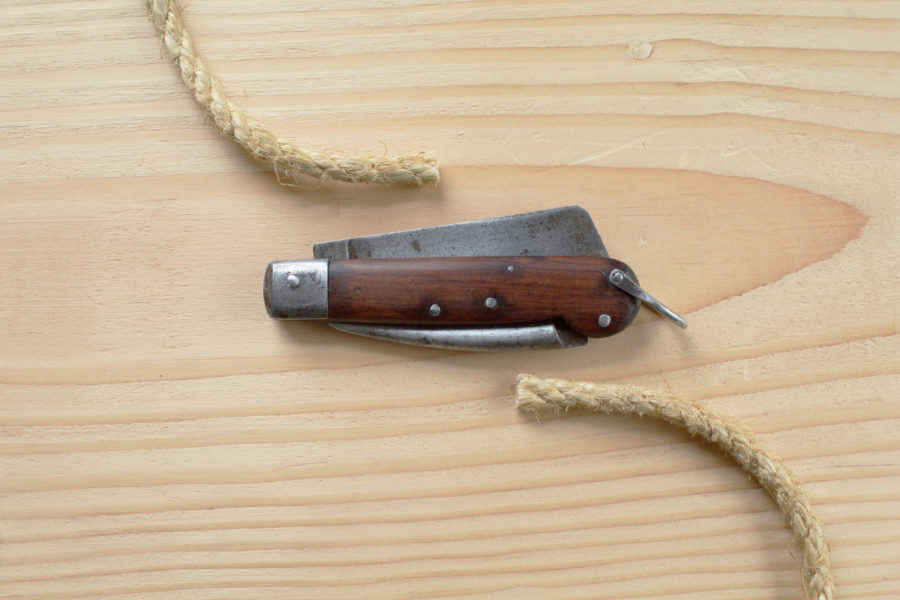
From The Editor
Lost and Found
I have a shelf in the corner of my shop where I pile my collection of tape measures. They frequently fall off the shelf, and this past week I got…
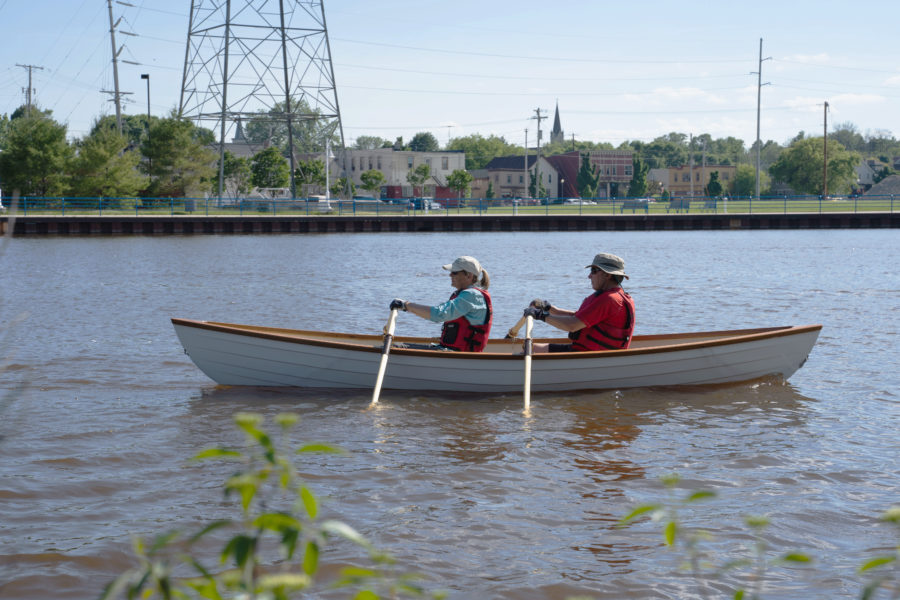
Boat Profile
Crawford’s Gunning Dory
Roger builds his boats one at a time. The Gunning Dory is hand-laid fiberglass starting with rolled-on gelcoat. The layup for the bottom includes biaxial fiberglass cloth, a 1/2″ foam…
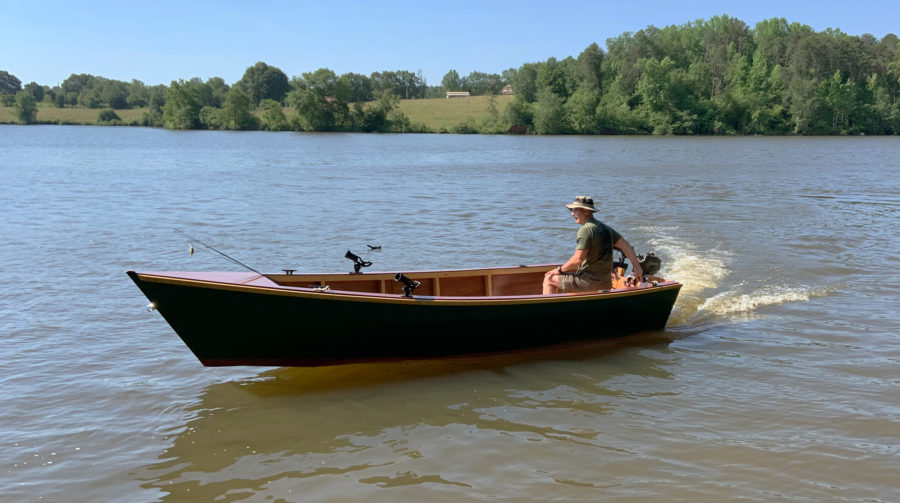
Spira’s Hudson Skiff
I have a full-sized pickup truck, so trailering the lightweight skiff is not at all difficult. Launching at the ramp is similarly not a problem; Hudson floated right off the…
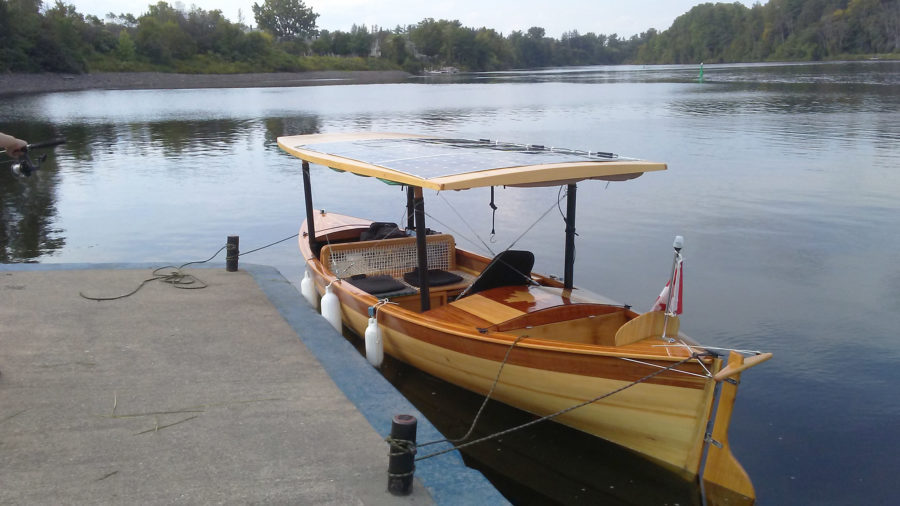
A Solar Solo
SOL CANADA had been performing fairly well, but about once an hour the motor would just stop. I could get it going again by putting the throttle neutral for a…
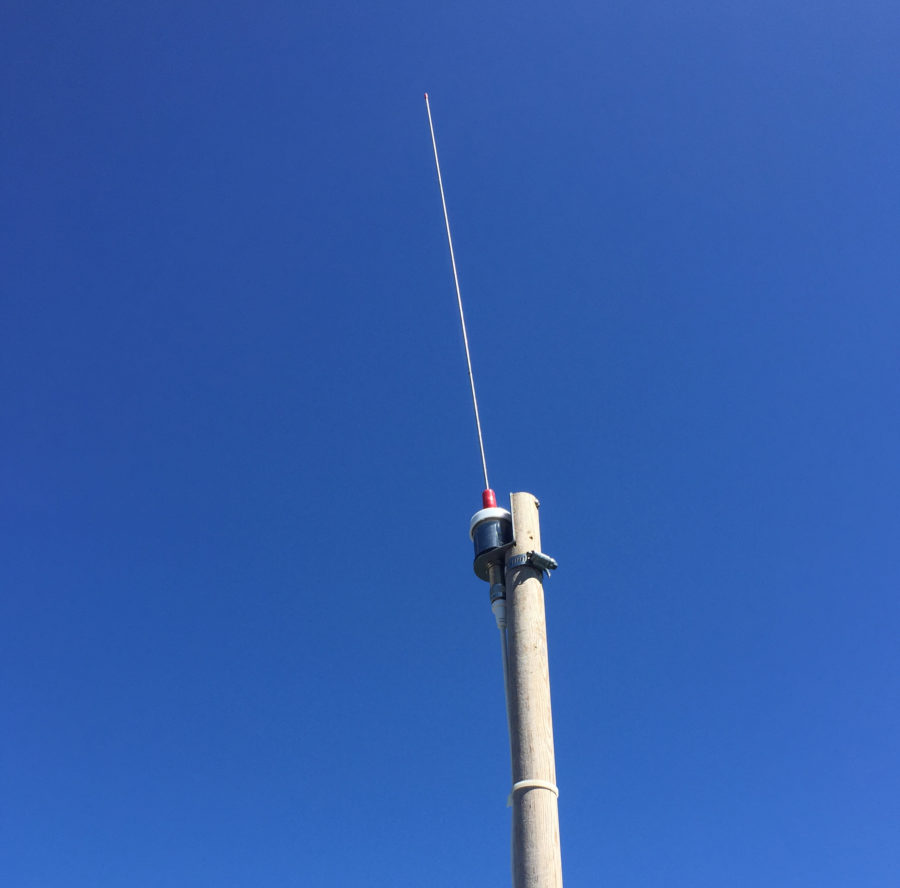
Antennas for VHF
VHF radios, like cell phones, are limited to line of sight. The Coast Guard sets its antennas up as high as possible, often in spots remote from their base, to…
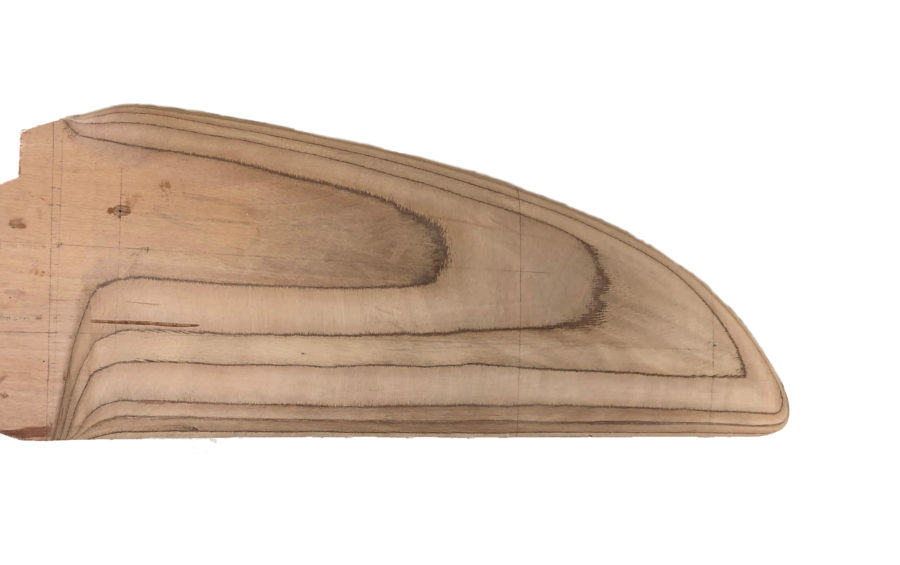
I made a blank for my rudder by gluing layers of marine ply with epoxy to the required 1″ thickness. I have found that the plywood, in spite of its…
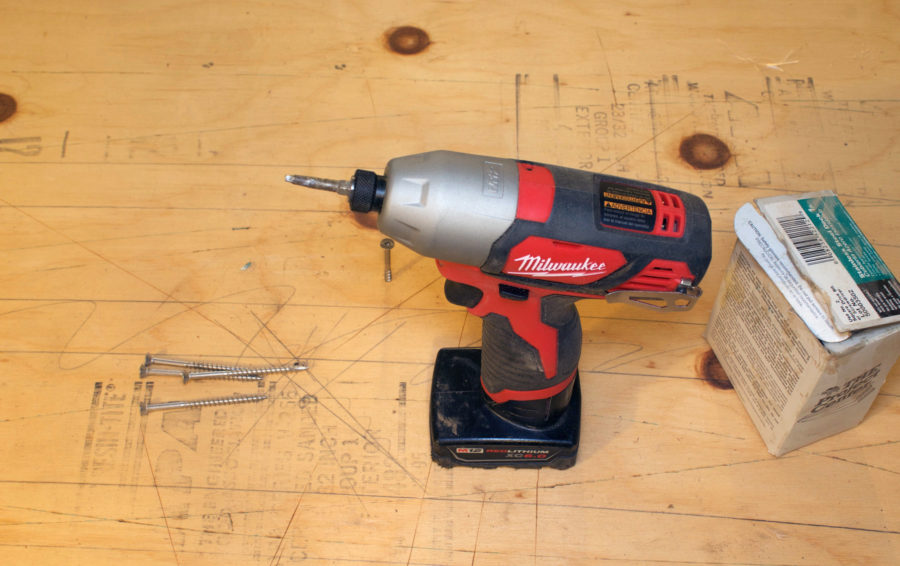
Product Reviews
Impact Drivers
While the impact driver has lots of power, more than enough to shear screws, the variable-speed trigger provides the operator with very good control for the depth of the screw.…
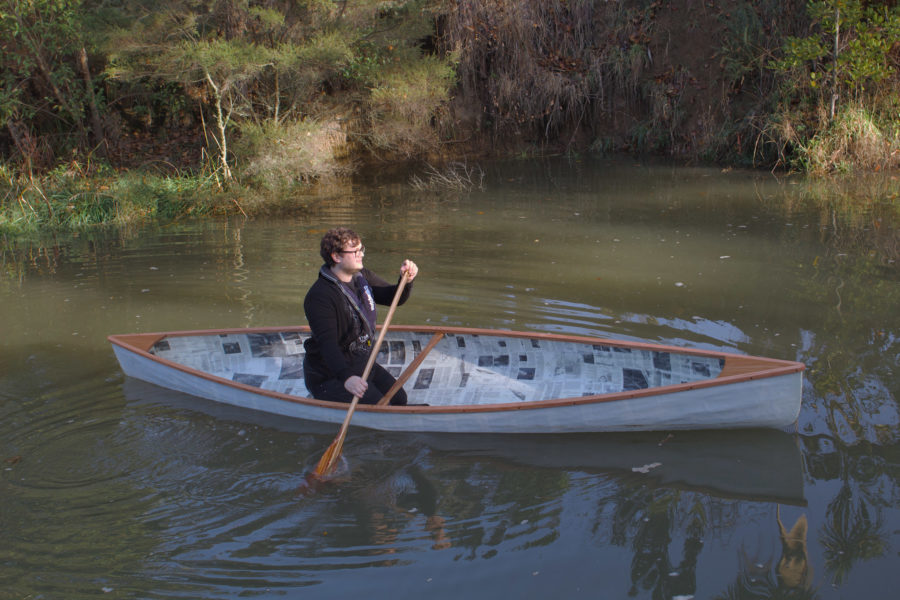
Reader Built Boats
Built by the Book
The lockdown in New Zealand began on March 23 and David stayed home to do his part in slowing the spread of COVID-19. He focused on his canoe projects and…
More Technique
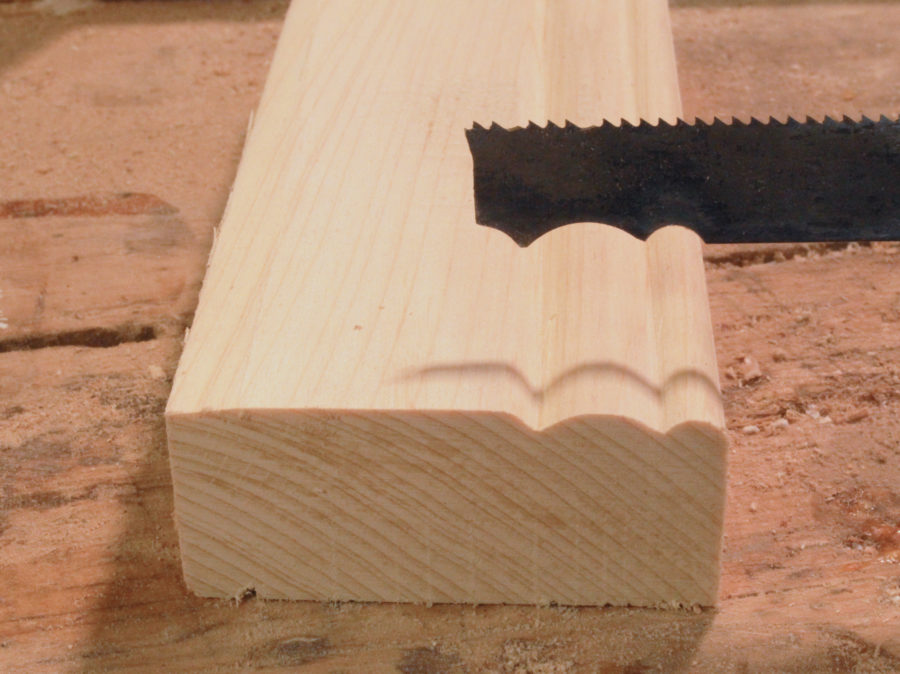
Profile Scrapers
There can be a lot of scrambling around on a small boat, so it’s best to take the curse off the edges of all the bits of wood. The rounded…
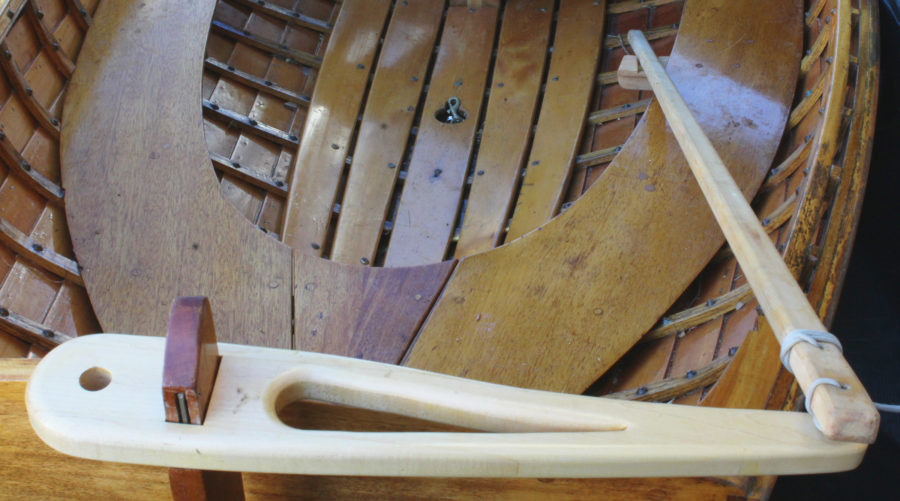
A Norwegian Tiller Keeper
Solo sailors of small open boats have a problem: While we’re sailing we’re stuck minding the helm. Occasionally there’s a need to go forward to adjust the downhaul or centerboard,…
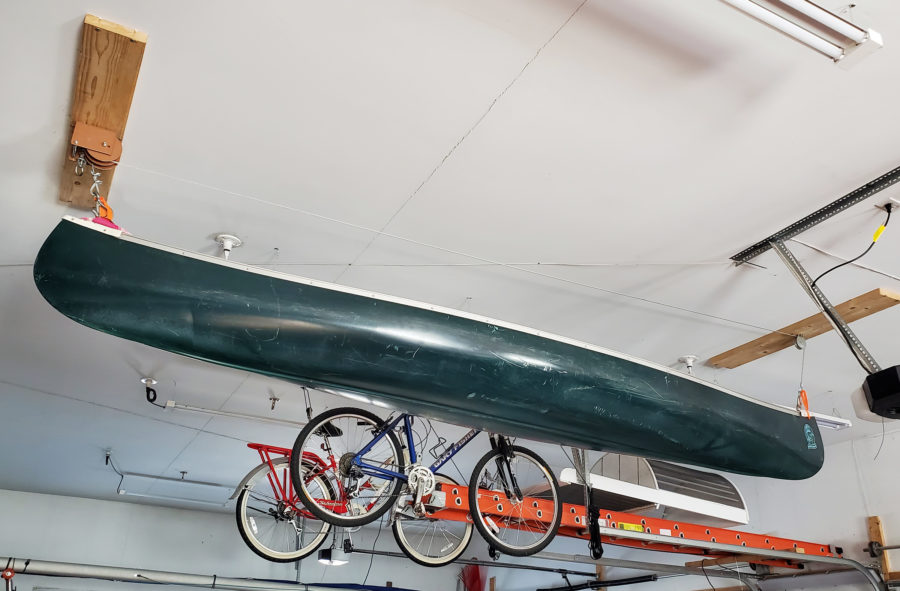
An Overhead Winch Lift
I decided to store the canoe above the overhead-door tracks in our 12′-high garage directly above a parking bay. To raise and lower it directly into the truck bed, I…
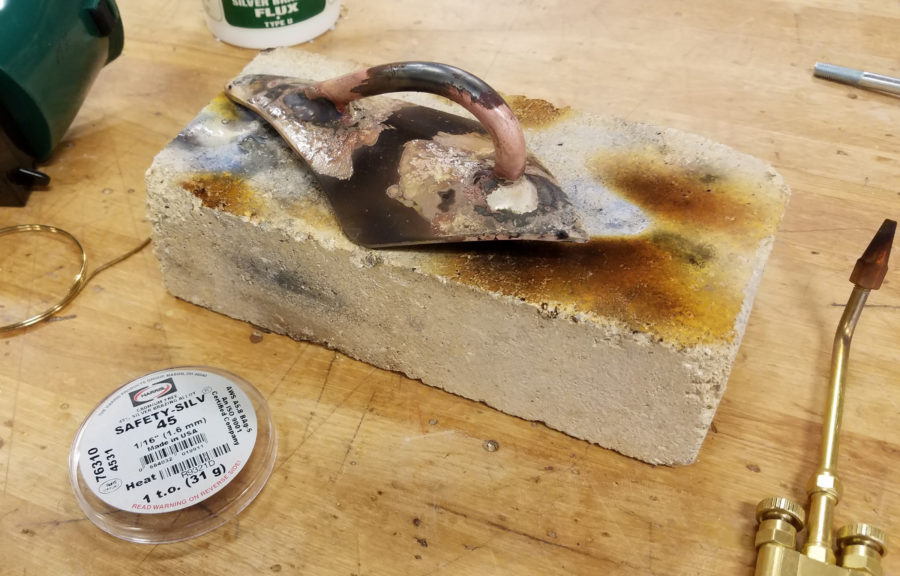
Fillet Brazing for Custom Boat Hardware
By using a brazing alloy that would build up in fillets at the intersections, the resulting radiused transitions would have the appearance of custom-cast fittings. After some experimentation with different…
Subscribe Today!
Become a subscriber today and you’ll recieve a new issue every month plus unlimited access to our full archive of backlogged issues.
Already a subscriber? Sign In
Subscribe For Full Access
Flipbooks are available to paid subscribers only. Subscribe now or log in for access.
- AROUND THE SAILING WORLD
- BOAT OF THE YEAR
- Email Newsletters
- America’s Cup
- St. Petersburg
- Caribbean Championship
- Boating Safety
- Ultimate Boat Giveaway

Boat of the Year 2020 F101: Best Foiler
- By Dave Reed
- Updated: December 10, 2019
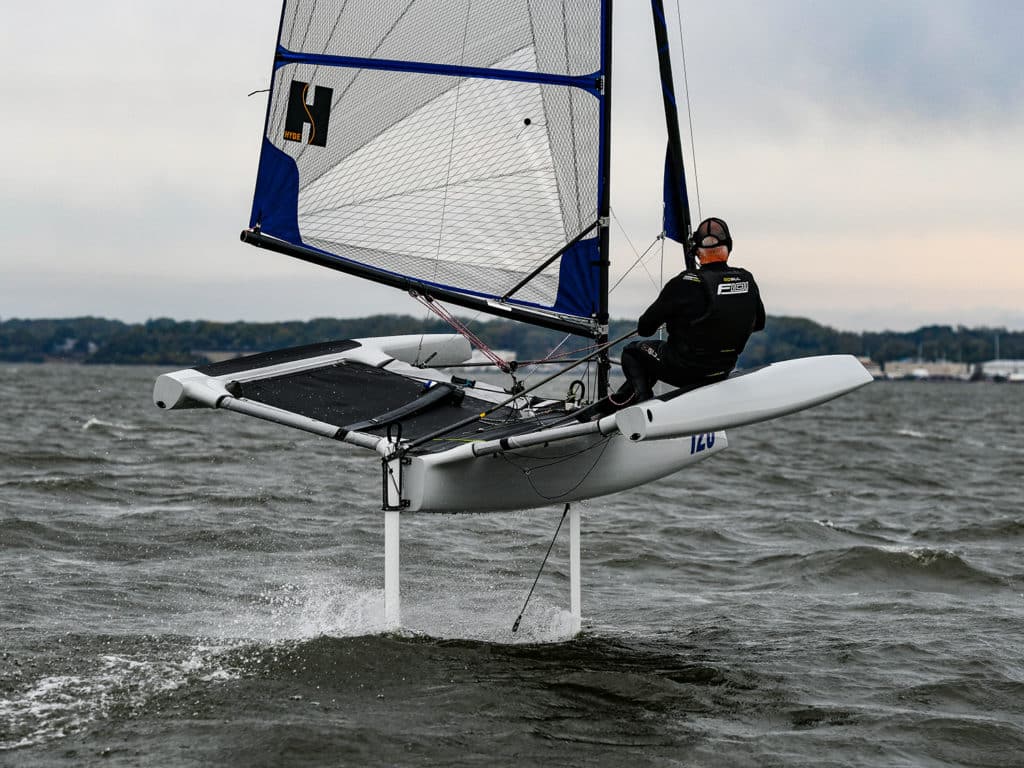
At A Glance
Price As Sailed: $24,750
Design Purpose: Learn to foil, advance skills
Crew List: One or two
Rob Andrews and his business partner Alan Hillman have been teaching foiling for a few years now, and one thing they’ve learned is we get better by sailing, not by swimming. Thus was the genesis of the F101, a craft with which they could teach the fundamentals of foiling—without the crash and burn. But it’s not just a learn-to-foil boat, either. It’s a platform with which new and experienced converts alike can take their foiling skill set to a higher level.
The key to mastering the F101, Andrews explains, is grasping righting moment. With the trimaran platform, you get plenty of it, as well as a stable boat that’s more forgiving than any other small foiler. “The trimaran configuration gives you righting moment direct from the foil in the middle hull,” he says, “and gives a measure of safety. It’s hard to capsize the boat.”
The judges learn as much when it comes time to sail the F101. In 15 knots and more, and a steep Chesapeake chop, Powlison is first to give it a go. He settles into the boat, gets his bearings, perches skittishly on the weather hull, sheets on the mainsail (no need to use the boat’s gennaker above 12 knots) and off he goes like a bat out of hell, popping up on the foils without even trying.
“The trick is getting used to the sensation of heeling to windward,” he says. “It takes a bit of trust. Once foiling, it’s quiet and fast, and I felt like I had to be really active on the mainsheet to keep it on the foils.”
That’s true of any foiler, but the beauty of the F101, the judges agree, is when you do lose it, it’s no big deal. The boat drops off its foils, the bows auger in and you get a face full of water; but just reset, bear away and try again.
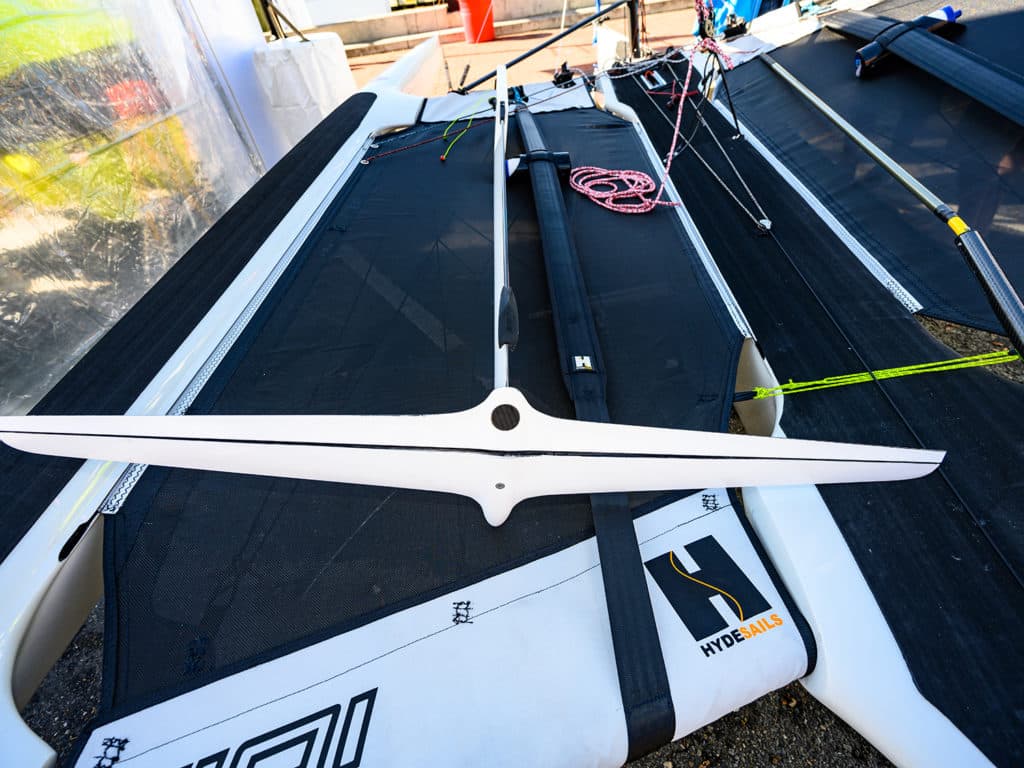
“The hull shape picks up the buoyancy gently,” Stewart says, “which makes it depress smoothly and prevents it from pitchpoling. When I dumped it a few times I thought I was going in, but not a chance. You quickly realize there’s plenty of floatation there to save you. In flat water, with one day of training you’d get up to speed quickly.”
When teaching people to foil, Hillman starts with “skimming,” a ride height barely above the surface. As the sailor becomes more accustomed to how the boat behaves, there’s a simple line adjustment at the foil head: Dial it up one setting and increase your ride height.
As you’re sailing, the foil wand hanging behind the trailing edge effectively feels where the boat is riding relative to the water and actuates the main flap. In light winds, it gives you more lift, and the boat pops up on the foil. Get too high, and the wand drops down even further, forcing negative lift on the flap, which brings you back down to your desired height and prevents the foils from breaking the surface.
In terms of construction, the judges praise its carbon-and-epoxy build quality and the all-up weight of 180 pounds, which makes it easy to get to and from the water. With the F101 sitting on its dolly in the boat park, going sailing is as simple as pulling back the covers, hoisting the main and launching from a dock, beach or boat ramp with minimal fuss.
“What I like about it is that it’s one of those boats that you buy and don’t need to add anything to it,” Allen says. “There’s nothing to change out or upgrade.”
For simplicity, the boat is set up with adjustments that let you ratchet up the experience as you climb the learning curve. On the rudder foil, for example, there is a clear numbering system so that as you twist the tiller extension, you change the rudder rake. The baseline setting is zero, and it’s the same for the main foil. The only thing left is to balance the forces with the mainsheet.
“When I first got up on the foils, I was thinking to myself, ‘This is too easy; I should be working harder,’ ” Powlison says. “As they said, this boat solves a lot of the problems associated with other foiling dinghies. It’s a great high-performance boat that represents the next step in making foiling accessible to the public.”
See All Winners
Other Winners:
- 2020 Boat of the Year
- Best Crossover
- Best Multihull
- Best Foiler
- Best Dinghy
- More: BOTY , boty 2020 , foils , Sailboats
- More Sailboats
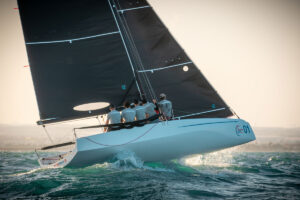
Sporty and Simple is the ClubSwan 28

Nautor Swan Has A New Pocket Rocket

Pogo Launches its Latest Coastal Rocket

A Deeper Dive Into the Storm 18

Mistakes And Misfires On the Final Day of Cup’s Preliminary Regatta

Emirates Team New Zealand Remain the Bullies of Barcelona

Start-Box Sparring in Barcelona on Day 2 of Preliminary Regatta

Real-time Wind Overlay Feature Added to Cup Broadcast

- Digital Edition
- Customer Service
- Privacy Policy
- Terms of Use
- Cruising World
- Sailing World
- Salt Water Sportsman
- Sport Fishing
- Wakeboarding

Published on June 2nd, 2017 | by Assoc Editor
Foiling and Foil Shapes, a Beginner’s Guide
Published on June 2nd, 2017 by Assoc Editor -->
by Mark Chisnell, Land Rover BAR The rules covering the design and construction of the team’s America’s Cup Class (ACC) boat have defined many of the parts of the boat, including the hull and crossbeams (together called the platform), and the wing shape and size. What’s left for the team’s designers and engineers to work on is principally the daggerboards and rudders, and the control systems that operate them along with the wingsail.
A lot of the technology that goes into the control systems is hidden well inside the hull, with just glimpses of the HMI (human machine interface) that the sailors use to control the board rake, wing trim and so on. The foils are on full view however, so we thought a beginners guide to ACC foil design would come in useful now the racing is approaching.
Basic Principles The foils use exactly the same scientific principles as an aircraft wing. Just as an aircraft wing will lift a plane up off the ground, the foils of an America’s Cup Class boat will lift it out of the water. Wings are foils too, called aerofoils because they work in air. The foils on the new America’s Cup boats are more accurately called hydrofoils, because they work in water.
The secret to both types of foil is the shape – aerofoils and hydrofoils use a special shape to guide the wind or water around them, and generate the lifting force to get planes and boats up in the air. Of course, the America’s Cup boats also use an aerofoil. The main wingsail works exactly the same way as an aircraft wing, it’s just rotated to stand up straight, rather than lie flat.

While an aircraft needs an engine to push the air over the wing fast enough to generate enough force to lift the aircraft up off the ground, the wingsail on the Cup boat generates force from the wind blowing past it. The harder the wind blows, the more force it makes to push the boat forward. When the boat is going fast enough, the hydrofoils will then be able to create enough force to lift the boat out of the water. This reduces resistance to the forward motion and the boat goes faster still.
There are four hydrofoils on the boat — we count the rudders at the back because they have small wings at the tips called elevators. However, the real power to keep the boat in the air comes from the hydrofoils (the daggerboards, as you will often hear them called by the sailors) and we will concentrate on these.
The L-Foil The L-foil is exactly that; a vertical daggerboard shaft that goes through the hull of the boat, with a single horizontal hydrofoil on the bottom, the whole thing shaped like an ‘L’. If nothing else changes, then the L-foil keeps generating lift as the boat goes faster and so the boat keeps rising, and as it rises, less and less of the daggerboard is in the water.
At the basic level, two things then happen: firstly, the boat starts to slip sideways because there is less of the vertical part of the daggerboard in the water and this makes the boat feel unstable and hard to steer. Then, ultimately, if the boat keeps rising the horizontal part of the board that is doing all the lifting will break the surface. If it does, there will be a catastrophic loss of lift and the boat will come crashing back down.
Aircraft use moving parts on the foils to control the amount of lift – trailing edge flaps — but the rules forbid these on the ACC boats, so to maintain stable flight the sailors change the rake or angle of attack of the whole dagger board (and hence the foil) to the water.
Rake If you rake the board backwards as the boat accelerates, the lift will reduce and the boat will come to an equilibrium at a steady height above the water. This is all well and good until the conditions change, maybe the wind speed goes up or down, or the boat hits some waves. When that happens the rake will need further adjustment to find the new equilibrium… until the next puff or lull when it must change again.
In the big breeze and rough water of San Francisco Bay in the 34th America’s Cup it turned out that these moments of equilibrium didn’t last very long and on occasions barely existed at all. The crew’s ability to generate the hydraulic power to change the board and wing trim was simply overwhelmed; they couldn’t achieve stable flight.
V-foil The solution was what’s called the V-foil, in which the horizontal part of the ‘L’ is angled upwards to form more of a ‘V’ shape (the angle at the bottom of the ‘V’ is called the dihedral – a dihedral of 90 degrees would define an L-foil, less than that is progressively more of a V-foil).
The V-foil uses the same principle as one of the most successful original foiling powerboats. The grand old man of 19th century innovation, Alexander Graham Bell put a couple of 350hp engines on the back of what was called HD-4 and set a new marine world speed record in 1919 of just over 70mph.
HD-4 used three ‘ladders’ of small foils, one at the front, and one each side close to the back. When the boat accelerated it started to lift out of the water, and as it lifted, one by one the ‘rungs’ of the foils would break clear of the water. As they did so the lift would decrease, and unless the boat continued to accelerate the boat would stop rising and settle at an equilibrium.
The V-foil achieves this same effect with a single foil and is used in the commercial application of fast ferries— one runs between Southampton and Cowes on the Isle of Wight, right across the Solent waters where the team train, and has done so (on and off) since 1969 – so V-foils are well understood.
When a boat equipped with a V-foil keeps rising as more lift is generated by faster speeds, both parts of the ‘V’ come out of the water together. Critically, when the ‘horizontal’ section starts to break the surface at the tip, it has the effect of reducing the lift gradually, because it doesn’t all come out of the water together. So the boat comes back down gently, working towards an equilibrium ‘ride height’ of its own accord.
It might be that it doesn’t reach this equilibrium before something else changes, but the V-foil has some inherent stability (unlike the L-foil) that doesn’t require human intervention. The shape provides a feedback mechanism to control the amount of lift and produce a more stable ride at a consistent height above the water. The downside of the V-foil is that it will generate less lift and more drag than the L-foil under the same conditions, because some of the lift generated is pushing sideways rather than up.
So one of the big questions facing the teams at the outset of this campaign was whether or not the sailors could achieve stable flight with an L-foil in the new boats and the new venue. Bermuda was a very different place to San Francisco; the winds were expected to be lighter, the water flatter and it seemed that stable flight should be easier to achieve with an L-foil under human control.
A huge amount of work has gone into foil and control system design and we now know that the answer is yes, they can – all the teams are using L-foils, often with unloaded dihedral angles of greater than 90 degrees. These angles close as the boat sails and the foil is loaded up to become much closer to, or 90 degrees.
Cant Another buzz word for the 35th America’s Cup is the cant. The cant of the board is similar to the rake, except that the bottom of the board is moving sideways across the boat, to and from the centreline, rather than backwards and forwards. When the board is canted outwards (towards the edge of the boat) it creates greater ‘righting moment’ and more power to drive the boat forwards.
Righting Moment When the wind hits a sail it creates the force to move the boat forward but it also creates a force that is trying to tip the boat over. If you have ever seen a dinghy or yacht knocked flat by a big gust of wind then you’ve already got the idea.
It’s considerably simplified, but essentially the more force that can be applied to resist the wind’s effort to tip the boat over, then the faster the boat will go, because more of the wind’s energy can be captured and applied to forward motion. The resisting force is called the righting moment and creating as much righting moment as possible is a fundamental principle of designing fast sailboats. It’s the reason that you see people leaning over the windward side when they are racing, putting bodies as far out on the windward side as possible is creating righting moment.
S-Foil Finally, there’s the question of whether the vertical part of the daggerboard should be straight or ‘S’ shaped. The curve of the S-foil could be used — like the cant — to move the bottom of the board outboard and increase the righting moment. So S-foils are more powerful, but they are also more difficult to use. The curves have to raised up and down through the bearings and internal mechanisms in the hull, and that means a lot of work to keep the friction down and the efficiency high.

Tags: AC35 , America's Cup , foiling , Land Rover BAR , Mark Chisnell
Related Posts

On the topic of the America’s Cup venue →
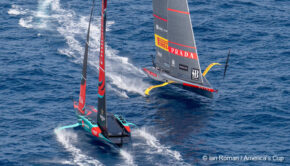
New Zealand picks up where they left off →

America’s Cup: What have we learned? →
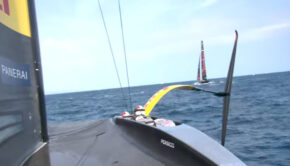
Not only boring, it is dehumanizing →
© 2024 Scuttlebutt Sailing News. Inbox Communications, Inc. All Rights Reserved. made by VSSL Agency .
- Privacy Statement
- Advertise With Us
Get Your Sailing News Fix!
Your download by email.
- Your Name...
- Your Email... *
- Comments This field is for validation purposes and should be left unchanged.


10 Best Small Sailboats (Under 20 Feet)
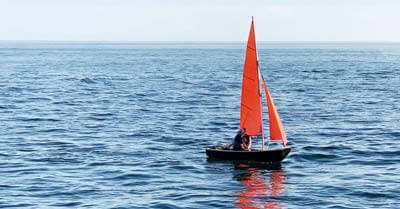
Last Updated by
Daniel Wade
December 28, 2023
Compact, easy to trailer, simple to rig, easy to maintain and manage, and affordable, the best small boats all have one thing in common: they offer loads of fun while out there on the water.
So whether you're on a budget or just looking for something that can offer ultimate daytime rides without compromising on safety, aesthetic sensibilities, alternate propulsion, and speed, the best small sailboats under 20 feet should be the only way to go.
Let's be brutally honest here; not everyone needs a 30-foot sailboat to go sailing. They come with lots of features such as electronics, entertainment, refrigeration, bunks, a galley, and even a head. But do you really need all these features to go sailing? We don't think so.
All you need to go sailing is a hull, a mast, rudder, and, of course, a sail. And whether you refer to them as daysailers, trailerable sailboats , a weekender sailboat, or pocket cruisers, there's no better way to enjoy the thrills of coastal sailing than on small sailboats.
There are a wide range of small boats measuring less than 20 feet available in the market. These are hot products in the market given that they offer immense thrills out on the sea without the commitment required to cruise on a 30-footer. A small sailboat will not only give you the feel of every breeze but will also give you the chance to instantly sense every change in trim.
In this article, we'll highlight 10 best small sailboats under 20 feet . Most models in this list are time-tested, easy to rig, simple to sail, extremely fun, and perfect either for solo sailing or for sailing with friends and family. So if you've been looking for a list of some of the best small sailboats , you've come to the right place.
So without further ado, let's roll on.
Table of contents
{{boat-info="/boats/hunter-15"}}
The Marlow-Hunter 15 is not only easy to own since it's one of the most affordable small sailboats but also lots of fun to sail. This is a safe and versatile sailboat for everyone. Whether you're sailing with your family or as a greenhorn, you'll love the Hunter 15 thanks to its raised boom, high freeboard, and sturdy FRP construction.
With high sides, a comfortable wide beam, a contoured self-bailing cockpit, and fiberglass construction, the Hunter 15 is certainly designed with the novice sailor in mind. This is why you can do a lot with this boat without falling out, breaking it, or capsizing. Its contoured self-baiting cockpit will enable you to find a fast exit while its wide beam will keep it steady and stable no matter what jibes or weight shifts happen along the way.
This is a small sailboat that can hold up to four people. It's designed to give you a confident feeling and peace of mind even when sailing with kids. It's easy to trailer, easy to rig, and easy to launch. With a price tag of about $10k, the Hunter 15 is a fun, affordable, and versatile boat that is perfect for both seasoned sailors and novices. It's a low-maintenance sailboat that can be great for teaching kids a thing or two about sailing.
Catalina 16.5
{{boat-info="/boats/catalina-16-5"}}
Catalina Yachts are synonymous with bigger boats but they have some great and smaller boats too such as Catalina 16.5. This is one of the best small sailboats that are ideal for family outings given that it has a big and roomy cockpit, as well as a large storage locker. Designed with a hand-laminated fiberglass sloop, the Catalina 16.5 is versatile and is available in two designs: the centerboard model and the keel model.
The centerboard model is designed with a powerful sailplane that remains balanced as a result of the fiberglass centerboard, the stable hull form, and the rudder. It also comes with a tiller extension, adjustable hiking straps, and adjustable overhaul. It's important to note that these are standard equipment in the two models.
As far as the keel model is concerned, this is designed with a high aspect keel as the cast lead and is attached with stainless steel keel bolts, which makes this model perfect for mooring or docking whenever it's not in use. In essence, the centerboard model is perfect if you'll store it in a trailer while the keel model can remain at the dock.
All in all, the Catalina 16.5 is one of the best small sailboats that you can get your hands on for as low as $10,000. This is certainly a great example of exactly what a daysailer should be.
{{boat-info="/boats/hobie-16"}}
There's no list of small, trailerable, and fun sailboats that can be complete without the inclusion of the classic Hobie 16. This is a durable design that has been around and diligently graced various waters across the globe since its debut way back in 1969 in Southern California. In addition to being durable, the Hobie 16 is trailerable, great for speed, weighs only 320 pounds, great for four people, and more importantly, offers absolute fun.
With a remarkable figure of over 100,000 launched since its debut, it's easy to see that the Hobie 16 is highly popular. Part of this popularity comes from its asymmetric fiberglass-and-foam sandwiched hulls that include kick-up rudders. This is a great feature that allows it to sail up to the beach.
For about $12,000, the Hobie 16 will provide you with endless fun throughout the summer. It's equipped with a spinnaker, trailer, and douse kit. This is a high-speed sailboat that has a large trampoline to offer lots of space not just for your feet but also to hand off the double trapezes.
Montgomery 17
{{boat-info="/boats/montgomery-17"}}
Popularly known as the M-17, The Montgomery 17 was designed by Lyle C. Hess in conjunction with Jerry Montgomery in Ontario, California for Montgomery Boats. Designed either with keel or centerboard models, the M-17 is more stable than most boats of her size. This boat is small enough to be trailered but also capable of doing moderate offshore passages.
This small sailboat is designed with a masthead and toe rail that can fit most foresails. It also has enough space for two thanks to its cuddly cabin, which offers a sitting headroom, a portable toilet, a pair of bunks, a DC power, and optional shore, and a proper amount of storage. That's not all; you can easily raise the deck-stepped mast using a four-part tackle.
In terms of performance, the M-17 is one of the giant-killers out there. This is a small sailboat that will excel in the extremes and make its way past larger boats such as the Catalina 22. It glides along beautifully and is a dog in light air, though it won't sail against a 25-knot wind, which can be frustrating. Other than that, the Montgomery 17 is a great small sailboat that can be yours for about $14,000.
Norseboat 17.5
{{boat-info="/boats/norseboat-17-5"}}
As a versatile daysailer, Norseboat 17.5 follows a simple concept of seaworthiness and high-performance. This small sailboat perfectly combines both contemporary construction and traditional aesthetics. Imagine a sailboat that calls itself the "Swiss Army Knife of Boats!" Well, this is a boat that can sail and row equally well.
Whether you're stepping down from a larger cruiser or stepping up from a sea kayak, the unique Norseboat 17.5 is balanced, attractive, and salty. It has curvaceous wishbone gaff, it is saucy, and has a stubby bow-sprit that makes it attractive to the eyes. In addition to her beauty, the Norseboat 17.5 offers an energy-pinching challenge, is self-sufficient, and offers more than what you're used to.
This is a small, lightweight, low-maintenance sailboat that offers a ticket to both sailing and rowing adventures all at the same time. At about 400 pounds, it's very portable and highly convenient. Its mainsails may look small but you'll be surprised at how the boat is responsive to it. With a $12,500 price tag, this is a good small sailboat that offers you the versatility to either row or sail.
{{boat-info="/boats/sage-marine-sage-17"}}
If you've been looking for a pocket cruiser that inspires confidence, especially in shoal water, look no further than the Sage 17. Designed by Jerry Montgomery in 2009, the Sage 17 is stable and should heel to 10 degrees while stiffening up. And because you want to feel secure while sailing, stability is an integral feature of the Sage 17.
This is a sailboat that will remain solid and stable no matter which part of the boat you stand on. Its cabin roof and the balsa-cored carbon-fiber deck are so strong that the mast doesn't require any form of compression post. The self-draining cockpit is long enough and capable of sleeping at 6 feet 6 inches.
The Sage 17 may be expensive at $25k but is a true sea warrior that's worth look at. This is a boat that will not only serve you right but will also turn heads at the marina.
{{boat-info="/boats/laserperformance-laser-sb3"}}
Having been chosen as the overall boat of the year for 2008 by the Sailing World Magazine, the Laser SB3 is one of the coolest boats you'll ever encounter. When sailing upwind, this boat will lock into the groove while its absolute simplicity is legendary. In terms of downwind sailing, having this boat will be a dream come true while it remains incredibly stable even at extraordinary speed.
Since its debut in 2004, the Laser SB3 has surged in terms of popularity thanks to the fact that it's designed to put all the controls at your fingertips. In addition to a lightweight mast, its T- bulb keel can be hauled and launched painlessly. For about $18,000, the Laser SB3 ushers you into the world of sports sailing and what it feels to own and use a sports boat.
{{boat-info="/boats/fareast-18"}}
As a manufacturer, Fareast is a Chinese boat manufacturer that has been around for less than two decades. But even with that, the Fareast 18 remains a very capable cruiser-racer that will take your sailing to the next level. In addition to its good looks, this boat comes with a retractable keel with ballast bulb, a powerful rig, and an enclosed cabin.
Its narrow design with a closed stern may be rare in sailboats of this size, but that's not a problem for the Fareast 18. This design not only emphasizes speed but also makes it a lot easier to maintain this boat. Perfect for about 6 people, this boat punches above its weight. It's, however, designed to be rigged and launched by one person.
This is a relatively affordable boat. It's agile, safe, well-thought-out, well built, and very sporty.
{{boat-info="/boats/chuck-paine-paine-14"}}
If you're in the market looking for a small sailboat that offers contemporary performance with classic beauty, the Paine 14 should be your ideal option. Named after its famous designer, Chuck Paine, this boat is intentionally designed after the classic Herreshoff 12.5 both in terms of dimensions and features.
This is a lightweight design that brings forth modern fin keel and spade rudder, which makes it agile, stable, and faster. The Paine 14 is built using cold-molded wood or west epoxy. It has varnished gunnels and transoms to give it an old-time charm. To make it somehow modern, this boat is designed with a carbon mast and a modern way to attach sails so that it's ready to sail in minutes.
You can rest easy knowing that the Paine 14 will not only serve you well but will turn heads while out there.
{{boat-info="/boats/wd-schock-lido-14"}}
Many sailors will attest that their first sailing outing was in a Lido 14. This is a classic sailboat that has been around for over four decades and still proves to be a perfect match to modern small boats, especially for those still learning the ropes of sailing.
With seating for six people, the Lido 14 can be perfect for solo sailing , single-handed sailing, or if you're planning for shorthanded sailing. While new Lido 14 boats are no longer available, go for a functional used Lido 14 and you'll never regret this decision. It will serve you well and your kids will probably fall in love with sailing if Lido 14 becomes their main vessel during weekends or long summer holidays.
Bottom Line
There you have it; these are some of the best small sailboats you can go for. While there are endless small sailboats in the market, the above-described sailboat will serve you right and make you enjoy the wind.
Choose the perfect sailboat, invest in it, and go out there and have some good fun!
Related Articles
I've personally had thousands of questions about sailing and sailboats over the years. As I learn and experience sailing, and the community, I share the answers that work and make sense to me, here on Life of Sailing.
by this author
Best Sailboats
Most Recent

What Does "Sailing By The Lee" Mean?
October 3, 2023

The Best Sailing Schools And Programs: Reviews & Ratings
September 26, 2023
Important Legal Info
Lifeofsailing.com is a participant in the Amazon Services LLC Associates Program, an affiliate advertising program designed to provide a means for sites to earn advertising fees by advertising and linking to Amazon. This site also participates in other affiliate programs and is compensated for referring traffic and business to these companies.
Similar Posts

Affordable Sailboats You Can Build at Home
September 13, 2023

Best Small Sailboats With Standing Headroom

Best Bluewater Sailboats Under $50K
Popular posts.

Best Liveaboard Catamaran Sailboats

Can a Novice Sail Around the World?
Elizabeth O'Malley
June 15, 2022

4 Best Electric Outboard Motors

How Long Did It Take The Vikings To Sail To England?

10 Best Sailboat Brands (And Why)
December 20, 2023

7 Best Places To Liveaboard A Sailboat
Get the best sailing content.
Top Rated Posts
Lifeofsailing.com is a participant in the Amazon Services LLC Associates Program, an affiliate advertising program designed to provide a means for sites to earn advertising fees by advertising and linking to Amazon. This site also participates in other affiliate programs and is compensated for referring traffic and business to these companies. (866) 342-SAIL
© 2024 Life of Sailing Email: [email protected] Address: 11816 Inwood Rd #3024 Dallas, TX 75244 Disclaimer Privacy Policy
TF10 Foiling Trimaran
Ultra-modern, morrelli & melvin design, craftsmanship, wij bouwen uw nieuwe foiling boot, the tf10 trimaran: the foiling flying machine.
After the foiling revolution, the TF10 foiling trimaran is now the evolution of foiling sailing. With the TF10 foiling trimaran, sailing and foiling can be reached by any sailor. The TF10 is an 11 m long one-design foiling trimaran, designed by the famous yacht designers Morrelli & Melvin . The TF10 is built and sold by DNA Performance Sailing.
The TF10 is suitable for a crew of 4-5 persons and can handle a wide range of sailing conditions. The construction consists of pre-preg carbon fibers with a Nomex honeycomb core. This provides a lightweight, yet safe and robust construction. The foiling TF10 trimaran is the perfect foiling boat for both pleasure trips and sailing fast in races.
The transport of the TF10 is also revolutionary: when folded, it is easy to transport. We supply the TF10 with a specially designed road trailer, launching by boat ramp or crane are both possible.
Foils create sailing comfort
Thanks to the sophisticated design, every sailor feels comfortable on the TF10 foiling trimaran. Regardless of age, gender or muscle strength. And regardless of the speed, which can quickly reach up to 30 knots! Safety and comfort were the two main focuses of the design. This is reflected in a number of elements:
- The bow is designed to cut through the waves. This results in less hits on waves, which greatly increases sailing comfort.
- The carbon benches with back support provide a comfortable seat for crew and helmsman.
- The wishbone boom (half windsurfer boom) provides the decksweeper mainsail layout to perform at its best. An additional advantage is that in a manoeuvre the sail is now the lowest point and not the carbon boom.
- A ‘Semi-ridged’ carbon fibre trampoline cloth has been specially designed to make the boat’s construction torsional stiff. It makes it easier to walk on and block’s splashing water from the foils.
- The TF10’s foils and T-rudders minimize pitch and roll movements. The rake angle of all four foils is adjusted with electric actuators. This system improves comfort and safety during sailing and foiling.
TF10 hydrofoils
The TF10 foiling trimaran flies with a 4-point foil setup:
- The T-rudders with horizontal elevators generate lift and/or downforce.
- The so called Z-type daggerboard foils provide the necessary lift to be able to foil.
- The advantage of the 4-point-foil setup is that the crew does not have to pick up the daggerboards during manoeuvres. This significantly reduces the crew’s actions.
- In addition, we have electric actuators that change the position of the foils and rudders with a single push on the button.
- The design of the Z-foils has already been very successfully applied to other foiling multihulls, such as the A-cats and the Olympic Nacra 17.
Specifications
Length incl. bowsprit: 10.94 m Length waterline: 9.97 m Beam: 6.8 m Beam incl. benches: 7.65 m Beam (folded on trailer): 2.5 m Minimum draft: 0.4 m Maximum draft: 2.55 m Height center hull: 1.78 m Mast length: 16.1 m Displacement leightship: 1400 kg Displacement max. load: 1900 kg Outboard engine: 6pk, retractable Mainsail: North Sails 3Di 45 m2 Jib: North Sails 3Di 28 m2 Gennaker: (on furler) 71 m2 LED Navigation lights
Fast and pure one-design racing Easy shipping Created by owners for owners
See and feel the future of sailing. The TF10 foiling trimaran is here!
This special foiling trimaran was designed at the end of 2015. The idea was to make a foiling multihull that anybody can sail and foil with. A foiling boat equipped with the same technology as the boats at the America’s Cup.
The TF10 and its sailing class is the result of initiatives by a group of five sailing friends on the East Coast of America (Newport, RI). They have joined forces and created the TF10 sailing class.
The members of the TF10 Class Association have lot’s of experience in various one-design racing series. The goal is to create a racing series that is as exciting, honest and fun as the boat itself.
Morrelli & Melvin designed a trimaran to combine the specific characteristics of a trimaran with foiling. The trimaran’s center hull offers important advantages here: its buoyancy and pitch stability eliminate the risk of ‘nose diving’ or ‘pitch poling’. In the design briefing, wind range and sea state (short sea shipping) were important. The design of the TF10 is based on this.
For all information, competitions and the latest news, please visit the TF10 Class website: www.TF10class.com
It is possible to make a trial run with the TF10. We do this on the IJsselmeer, just a few kilometres from DNA’s shipyard. Here the sailing and foiling conditions are perfect: There is always wind and you can fully enjoy the beautiful surroundings. The IJsselmeer lies between the cities of Lelystad, Almere and Enkhuizen. The new island area “Markerwadden” can also be seen and possibly visited here. Mail us at [email protected]
Schrijf je in voor onze nieuwsbrief en blijf op de hoogte van de nieuwste ontwikkelingen!

Contactformulier
- Company Name
- Full name * First Last
- Emailaddress *
- Phonenumber *
- Mijn vraag betreft * My question: TF10 F1x G4 F4 Custom Parts Hydrofoils Other
- Email This field is for validation purposes and should be left unchanged.
Registrieren Sie sich für unseren Newsletter
lassen Sie sich über die neuesten Entwicklungen informieren!
- E-Mail-Adresse *
- Name This field is for validation purposes and should be left unchanged.
Schrijf je in voor onze nieuwsbrief
blijf op de hoogte van de nieuwste ontwikkelingen!
- First name *
- Last name *
Wij gebruiken cookies om u de beste online ervaring te bieden. Door akkoord te gaan, accepteert u het gebruik van cookies in overeenstemming met ons cookiebeleid.
Wanneer u een website bezoekt, kan deze informatie in uw browser opslaan of ophalen, meestal in de vorm van cookies. Beheer hier uw persoonlijke cookiediensten.
- wordpress_test_cookie
- wordpress_logged_in_
- wordpress_sec

Service Locator
- Angler Endorsement
- Boat Towing Coverage
- Mechanical Breakdown
- Insurance Requirements in Mexico
- Agreed Hull Value
- Actual Cash Value
- Liability Only
- Insurance Payment Options
- Claims Information
- Towing Service Agreement
- Membership Plans
- Boat Show Tickets
- BoatUS Boats For Sale
- Membership Payment Options
- Consumer Affairs
- Boat Documentation Requirements
- Installation Instructions
- Shipping & Handling Information
- Contact Boat Lettering
- End User Agreement
- Frequently Asked Questions
- Vessel Documentation
- BoatUS Foundation
- Government Affairs
- Powercruisers
- Buying & Selling Advice
- Maintenance
- Tow Vehicles
- Make & Create
- Makeovers & Refitting
- Accessories
- Electronics
- Skills, Tips, Tools
- Spring Preparation
- Winterization
- Boaters’ Rights
- Environment & Clean Water
- Boat Safety
- Navigational Hazards
- Personal Safety
- Batteries & Onboard Power
- Motors, Engines, Propulsion
- Books & Movies
- Cockpit Confessions
- Communication & Etiquette
- Contests & Sweepstakes
- Colleges & Tech Schools
- Food, Drink, Entertainment
- New To Boating
- Travel & Destinations
- Watersports
- Anchors & Anchoring
- Boat Handling
- ← Technology
Hydrofoils: Boats That Fly
Advertisement
Hydrofoils make everything from water skis to sailboats to giant ferries faster (much faster). But how the heck do they work?
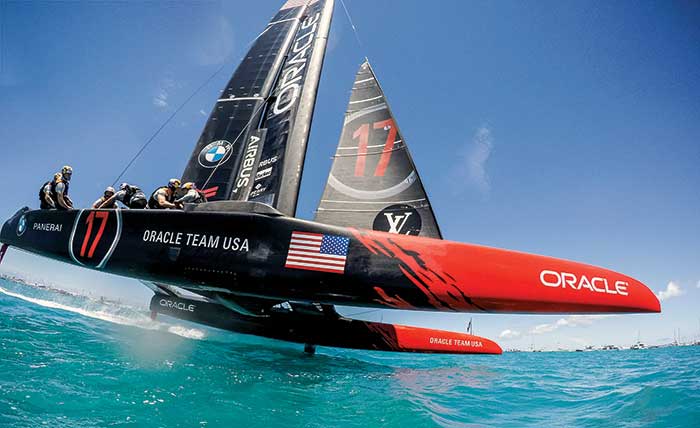
Oracle Team USA's AC50 "flying" at nearly 50 mph. (Photo: Ricardo Pinto)
Ever wonder why a sleek, powerful recreational boat is not even as fast as a typical economy car? It has to do with friction. An economy car needs a little over 100 horsepower to speed by at 100 mph, but pushing a boat through the water that fast takes several hundred horsepower. The reason is that water is almost 800 times denser than air.
Imagine standing on your dock in a 10-knot wind — it's not hard to do. Now imagine being in a river trying to stand up to a 10-knot current. The water is so much denser that no matter how strong you are, you'd be swept away. A boat hull has to push through all that dense water while a car can slip through the air much easier.
Planing boats are able to go faster than displacement boats because they lift part of their hull out of the water as they race over their bow wave, but there's still a lot of friction from the water on the rest of the hull. If you could get the hull all the way out of the water, you'd eliminate that friction, and the boat could go faster with the same amount of power.
The Science
Most of us have a pretty good understanding of how an airplane flies. As air flows over and under the wings (also called airfoils), it creates lift. Once an airplane is going fast enough, the lift that the wings create allow it to rise above the earth.
If you were to mount a wing or two (called hydrofoils) under a boat, all that dense water can be put to good use by pushing the boat's hull out of the water. Then friction only acts on the small foils, not on the whole hull, which is why a 130-foot hydrofoiling sailboat can "fly" at over 50 knots. Powerboats have added friction from the propulsion system that has to remain in the water, but even then, large hydrofoiling ferries can exceed 45 knots.
Speed is not the only advantage that hydrofoils give boats. Because the hull is out of the water, all the energy from waves that would normally pound against the boat pass harmlessly underneath it, creating an eerily smooth ride. Even so, hydrofoiling is typically best in somewhat protected waters.
Don't look for hydrofoils on your next runabout anytime soon because they're much more difficult to engineer and typically triple the cost of a boat. The good news is that there are other ways to 'foil that are affordable — see "Experience Hydrofoiling For Yourself" at below.
Experience Hydrofoiling For Yourself
Hydrofoil kiteboards.
If you've even seen a kiteboard zooming in a strong breeze, you know they're plenty fast. Add a hydrofoil, and suddenly you add a new dimension. These boards take lots of skill and practice to master, but the ride is said to be much smoother and even faster than a conventional kiteboard. Cost starts at around $1,000.
Hydrofoil Waterskis
These single-ski hydrofoils are really a sit-on-ski, and once you've mastered the technique, the foils will lift you up and you'll be "flying." Unlike conventional skis, these aren't designed for speed, and 18 mph is where they typically "liftoff' and suggested top speed is about 25 mph. It's also important not to ski in shallow water due to the depth of the foils. Cost is typically $1,500 and up.
Hydrofoil Windsurfers
Not content to take a surfboard and add a sail, windsurfers developed foils that allow the board to "levitate." The biggest advantage is the smoothness of the ride — a real benefit because these rigs usually sail in very strong winds with plenty of chop. Cost is about $2,500 to get started.
Hydrofoiling Small Sailboats
You don't have to spend millions on a boat like the America's Cup racers if you want to hydrofoil. The Waszp costs about $10,000, though even for dinghy racers, there's a learning curve to get these boats on their foils, with speeds up to 27 mph.
Note that most companies suggest wearing a helmet when using foiling products because of the speeds achievable and the hard, sharp foils these devices have.
Foiling The Competition
America's Cup boats are often what people think of when they hear the word "hydrofoil." Hal Youngren, an aeronautical engineer and one of the designers for the 2013 and 2017 America's Cup racers, says the difference in speed that foils make is impressive. The fastest nonfoiling catamarans in previous races could barely reach 35 knots, while the 2017 foiling cats hit 50 knots. Youngren says that these 50-foot cats are able to lift their hulls completely out of the water using only about three-quarters of a square meter of foil area (about the size of a medium-sized TV). Below about 15 knots, he says, the boats sail much like a nonfoiling boat with hulls in the water, but once over that speed, the boats start to "fly" and their speed dramatically increases.
The America's Cup Class AC75 Boat Concept Revealed
An exciting new era in America's Cup racing was unveiled in November 2017 as the concept for the AC75, the class of boat to be sailed in the 36th America's Cup is released illustrating a bold and modern vision for high performance fully foiling monohull racing yachts.
The America's Cup AC75 Boat Concept Revealed
The Emirates Team New Zealand and Luna Rossa design teams spent the previous four months evaluating a wide range of monohull concepts. Their goals have been to design a class that will be challenging and demanding to sail, rewarding the top level of skill for the crews; this concept could become the future of racing and even cruising monohulls beyond the America's Cup.
The AC75 combines extremely high-performance sailing and great match racing with the safety of a boat that can right itself in the event of a capsize. The groundbreaking concept is achieved through the use of twin canting T-foils, ballasted to provide righting-moment when sailing, and roll stability at low speed.
An underlying principle has been to provide affordable and sustainable technology "trickle down" to other sailing classes and yachts. While recent America's Cup multihulls have benefitted from the power and control of rigid wing sails, there has been no transfer of this technology to the rigs of other sailing classes. In tandem with the innovations of the foiling system, Emirates Team New Zealand and Luna Rossa are investigating a number of possible innovations for the AC75's rig, with the requirement that the rig need not be craned in and out each day. This research work is ongoing as different concepts are evaluated, and details will be released with the AC75 Class Rule before March 31, 2018.
The America's Cup is a match race and creating a class that will provide challenging match racing has been the goal from the start. The AC75 will foil-tack and foil-gybe with only small maneuvering losses, and given the speed and the ease at which the boats can turn the classic pre-starts of the America's Cup are set to make an exciting comeback. Sail handling will also become important, with cross-overs to code zero sails in light wind conditions.
A huge number of ideas have been considered in the quest to define a class that will be extremely exciting to sail and provide great match racing, but the final decision was an easy one: the concept being announced was a clear winner, and both teams are eager to be introducing the AC75 for the 36th America's Cup in 2021. — AmericasCup.com
Related Articles
The truth about ceramic coatings for boats.
Our editor investigates the marketing claims of consumer-grade ceramic coatings.
Fine-Tune Your Side Scan Fishfinder
Take your side-scanning fishfinder off auto mode, and you’ll be spotting your prey from afar in no time
DIY Boat Foam Decking
Closed-cell foam flooring helps make boating more comfortable. Here’s how to install it on your vessel
Click to explore related articles
Charles Fort
Contributing Editor, BoatUS Magazine
Charles Fort is BoatUS Magazine's West Coast Editor. He often writes local news items for BoatUS Magazine's Waypoints column and contributes to Reports, in-depth tech features in every issue written to help readers avoid accidental damage to their boats. He is a member of the National Association of Marine Surveyors, he's on ABYC tech committees, and has a 100-ton U.S. Coast Guard license. He lives in California.
BoatUS Magazine Is A Benefit Of BoatUS Membership
Membership Benefits Include:
Subscription to the print version of BoatUS Magazine
4% back on purchases from West Marine stores or online at WestMarine.com
Discounts on fuel, transient slips, repairs and more at over 1,200 businesses
Deals on cruises, charters, car rentals, hotel stays and more…
All for only $25/year!
We use cookies to enhance your visit to our website and to improve your experience. By continuing to use our website, you’re agreeing to our cookie policy.
Yachting World
- Digital Edition

Monofoil: The pocket rocket that can foil in just 8 knots of breeze
- Matthew Sheahan
- October 1, 2019
Built and developed in secret, the 8m Monofoil is a super-fast one-off foiling monohull, originally designed as a lake racer
The spectacle of a flying catamaran, be it an Olympic Nacra 17, a GC32, the recent America’s Cup 50-footers, or anything in between, has become almost normal in today’s racing world, so rapid has the shift to foiling been among multihulls.
But, even 17 years after they first appeared, the sight of a diminutive foiling Moth still turns heads. Foilers don’t have to be big to be impressive, balancing a single hull on a single foil is enough. Like those who can ride a unicycle, there’s something awe-inspiring about watching sailors who have pitch perfect balance fly a twitchy monohull while making it look like the most natural thing in the world.
There have been plenty of attempts to bring monohull foiling to bigger boats and to the masses. Yet no one has yet cracked the code, at least not for production boats.

Little surprise then, that whenever a new monohull foiler comes onto the scene it attracts plenty of attention. One of the latest is the 8m Swiss-built Monofoil. This extraordinary and complex looking boat is essentially a sportsboat with an open cockpit but with outrigger foils, like bicycle stabilisers, that generate righting moment by pushing upwards on the leeward side.
She was designed by Swiss match racing sailor Eric Monnin and built by Damian Weiss, both of whom shared a common goal: to create a fast foiling monohull for the European lakes.
Interestingly, neither had any desire to create a production version, nor tell the world that this was the answer for others. Instead, they simply wanted to find out if they could fly fast enough on one hull to stand a chance of winning some of the big prizes at Europe’s top lake races, including the famous Bol D’Or Mirabaud.
Article continues below…

Charal: On board the radical IMOCA 60 that takes foiling to the next level
In St Malo for the start of the Route du Rhum in early November, every inch of the IMOCA 60…

Eagle Class 53: The foiling cruiser inspired by the America’s Cup
Not everything that flies is destined to scorch around an America’s Cup course. The future for sailing hydrofoils is surely…
Launched in the spring of 2018 after two years of secret development, the initial signs looked good as the 8m sportsboat delivered an impressive opening performance, topping 25 knots on one of her first outings.
After a winter of tweaking and refining, where the team had increased the foils by 20% and reduced her overall weight by 50kg, the Monofoil was back afloat for this season. Shortly after her re-launch at Easter, it was clear that the team had raised the game.
“We can now foil upwind in just 8 knots of breeze,” said Monnin. “And when the breeze builds to 12 knots we are travelling at 16-20 knots at a true wind angle of around 50-60°. When it comes to downwind performance we can happily sit at 22 knots in 12 knots of wind with the gennaker. After that, when the breeze is up to 15-20 we are holding 24-27 knots with just the main and jib,” he continued.

The carbon bowsprit is 1.2m long and cants so the tack of the gennaker can be set further to windward, allowing the Monofoil to sail deeper
All impressive stuff for an 8m monohull. This is a proper pocket rocket that weighs just 650kg and can be rigged off the road trailer and launched in a couple of hours. Indeed, Monnin explains, her performance was in part limited by the need to keep the maximum beam down to 2.5m to meet European towing regulations.
Single hull foiling
So how does the Monofoil work? Setting the foils to one side to start with, the 8m long sportsboat flies a self-tacking jib upwind and a gennaker off a canting bowsprit downwind. She is designed to be raced by a full crew of four, including the helmsman, with two on trapezes to boost the righting moment.
She has a large square-topped mainsail that makes full use of the available space in a sail plan that sees the boom extend all the way to the transom where a full width traveller allows plenty of mainsheet tension to keep the head of the main stand up. This does mean she has a pair of running backstays rather than a single fixed stay, but double aft swept spreaders provide sufficient fore and aft support for the mast.

The foil deployed, but in the raised position. Normally it wouldn’t be underwater but the boat was heeled at the dock
Being a potent performer, she sails at high apparent wind speeds with the apparent wind ahead of the beam. This makes the full width mainsheet traveller an important feature to allow the mainsail to be dropped down to leeward while still maintaining leech tension, much like a multihull.
Her rudder is mounted on a transom-hung gantry to ensure greater efficiency for the T-foil blade. The rake of the rudder can be adjusted to alter the fore and aft trim of the boat.
While the foils look large and complex, their operation is surprisingly simple and belie the amount of work that has gone into designing a complete system that allows the curved foils to slide through a set of bearings in the hull.

A simple rope-driven worm drive alters the rake of the T-foil rudder, which in turn alters the trim of the boat. The rudder is mounted on a gantry off the transom to minimise cavitation
Much like the Beneteau Figaro 3, the idea is that both boards are lowered when sailing. Yet unlike the Figaro, the windward board is lifted partially to help raise it above the water’s surface and reduce the chances of it becoming immersed where it would create drag.
The clever part is the small amount of movement that is required to lift and lower the boards, especially when compared to the amount of movement required to raise and lower daggerboards on a modern multihull.
Also unlike the Figaro, the Monofoil’s boards are fully retracted in light winds. With very little of the foil in the water there is minimal drag and the boat can be sailed like any other monohull.

A custom bearing lets the daggerboard slide vertically to be raised or lowered. Rake is adjusted by the green line winding a worm drive
In these conditions the skinny and efficient 2.2m deep keel, with its 160kg bulb, is a good combination when the breeze is below 8 knots and allows the Monofoil to perform like any other similarly sized sportsboat.
The dihedral (upwards angle) of the foils is also an interesting feature that provides a degree of automatic heel control. As the boat accelerates and comes upright, so less of the foil is in the water, which reduces vertical lift.
Deceptively simple
At rest this boat does look pretty complex, yet once she’s rigged and underway you realise how simple she is to operate as well as how much effort has gone into designing her that way.

Below decks the full carbon construction is clear to see
This is an ingenious trailer-sailer that will fly in light conditions and be stable on foils right up through the wind range, something the crew demonstrated during this year’s Mirabaud Bol d’Or. As a vicious 50-plus knot storm swept through the fleet, she and her crew were one of the few to survive unscathed and go on to complete the overnight race.
The irony remains that – unlike many others in the Bol d’Or – this is not a boat that was intended to be the prototype for a new range of production foilers, even though she appears to provide answers to plenty of questions.
The bottom line is that the Monofoil seems to work. Irrespective of what speeds she clocks up, what is most impressive is how she performs across such a wide range of wind speeds.

Rectangular cut-outs in the hull allow the foil to be lowered completely on the leeward side. The windward foil is raised slightly in a similar way to pulling up a normal daggerboard
The Monofoil is no one-trick pony and while the concept wasn’t created for production, it could provide an appealing route for those who are realistic about their ability to learn how to balance like a Moth sailor, or ride a unicycle.
Specification
LOA: 8.0m (26ft 3in) Beam: 2.5m (8ft 2in) Displacement (empty): 850kg (1,874lb) Mast height: 12.2m (40ft 0in) Mainsail area: 32m 2 (345ft 2 ) Headsail area: 16m 2 (172ft 2 ) Gennaker area: 50m 2 (538ft 2 )
- BOAT OF THE YEAR
- Newsletters
- Sailboat Reviews
- Boating Safety
- Sails and Rigging
- Maintenance
- Sailing Totem
- Sailor & Galley
- Living Aboard
- Destinations
- Gear & Electronics
- Charter Resources
- Ultimate Boat Giveaway

Hydrofoils for Sailboats
- By By Steven Callahan
- Updated: July 29, 2020
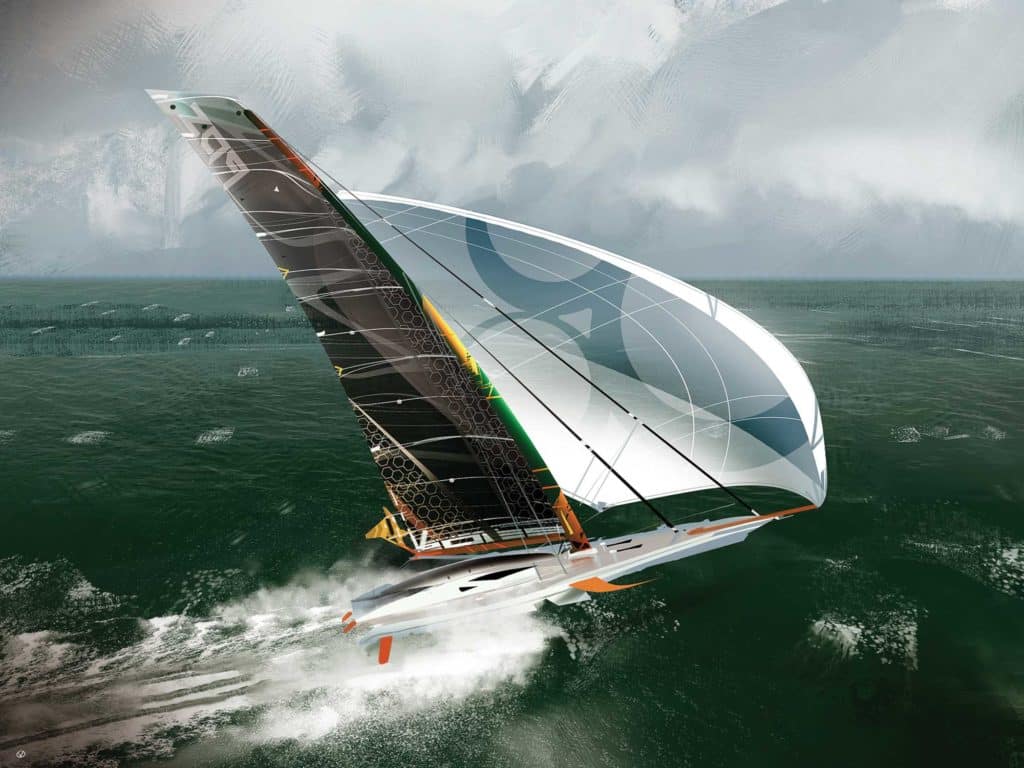
Hydrofoils have been providing dynamic lift since fish sprouted fins. And people have been employing foils ever since they first put paddle to water, and certainly since adding keels and rudders to boats. But the modern, flying America’s Cup boats, kiteboards, Moth dinghies, shorthanded offshore thoroughbreds—these are all playing in a new world in which the terms “hydrofoils” or “lifting foils” describe those oriented to raise a hull or hulls from the water. In these racing realms, if you ain’t got foils, you ain’t got nothin’.
Lifting foils that allow these boats to sometimes home in on three times the wind speed might appear to be of little interest to cruising sailors, but with such common cruising features as self-steering and autopilots, self-tailing winches, rope clutches, fin keels and faster hull shapes all having been passed down from the racing scene, one must ask, “What promise, if any, do hydrofoils hold?”
Lifted or partially lifted boat patents extend back to 1869, but workable watercraft took roots along with early flight. Italian Enrico Forlanini began experimenting with foils in 1898. In 1906, his 1-ton 60 hp foiler reached 42.5 mph. Alexander Graham Bell’s HD-4 Hydrodrome flew on Bras d’ Or Lake at 70 mph in 1919. And several sailing foiler patents began appearing in the 1950s. Notably, JG Baker’s 26-foot monohull, Monitor, flew at 30-plus mph in 1955. Baker experimented with a number of foil configurations, and at least built, if not used, the first wing mast. The first offshore foiler was likely David Keiper’s flying trimaran, Williwaw , in which he crisscrossed the Pacific in the 1960s.
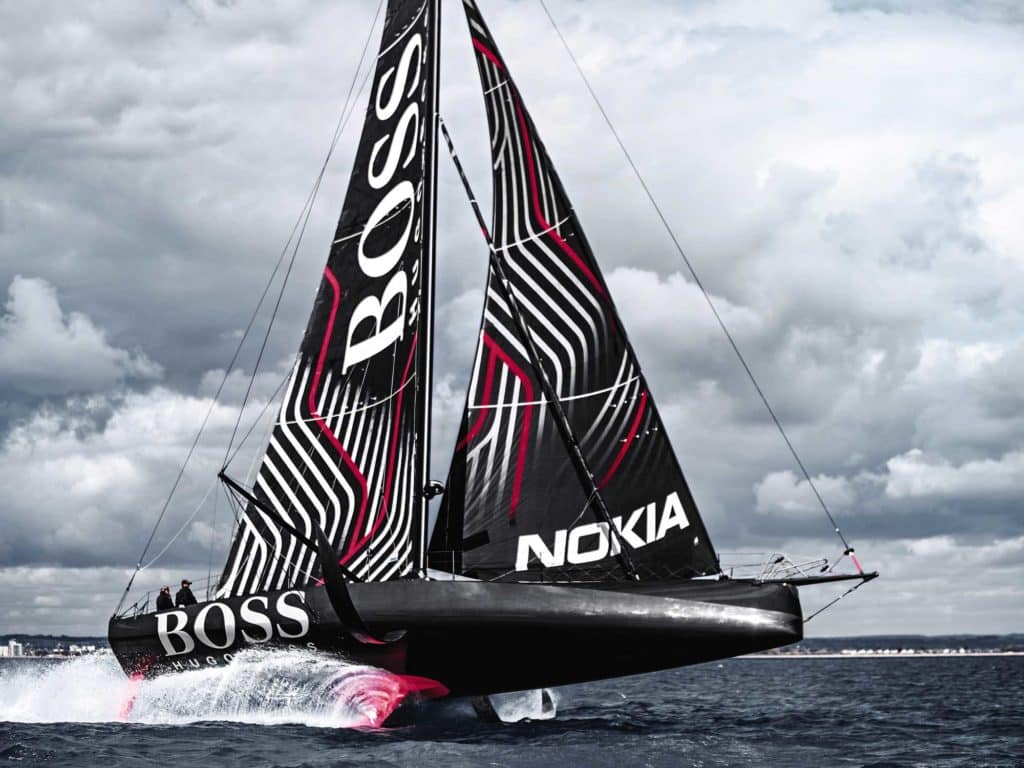
By the 1980s, numerous speed-trial and foil-enhanced offshore-racing multihulls showed huge promise, and have since evolved into behemoth trimarans clocking 30 to 40 knots continuously for long periods, not to mention the monohulls in the Vendée Globe (and soon the Ocean Race) that are capable of speeds exceeding 30 knots. But as boat designer Rodger Martin once reminded me, “If you want a new idea, look in an old book.” He was right. The fully foiling monohulls that will compete in the 2021 America’s Cup will bring things back full circle to the foiling monohull Monitor .
Fluid Dynamics Primer
Any foil—a wing, sail, keel, rudder or lifting foil—redirects the flow of fluid (air included), creating high- and low-pressure areas on opposite sides of the appendage, while developing lift perpendicular to the foil’s surface.
Advancements in foiling science is due in part to the hundreds of foil shapes that were tested, with tabulated results, by the National Advisory Committee for Aeronautics, the forerunner of the National Aeronautics and Space Administration. For the better part of a century now, aircraft and boat designers have been able to choose from a spectrum of refined foil sections that produce predictable amounts of lift and drag for known speeds of fluid and angles of attack, or the angle at which the foil passes through the fluid. Sections of efficient faster foils, as seen on jets or as we flatten our sails to go upwind or reach high speeds, have smaller nose radii and are thinner, with the thickest section of the foils farther aft, up to nearly halfway toward the trailing edge.
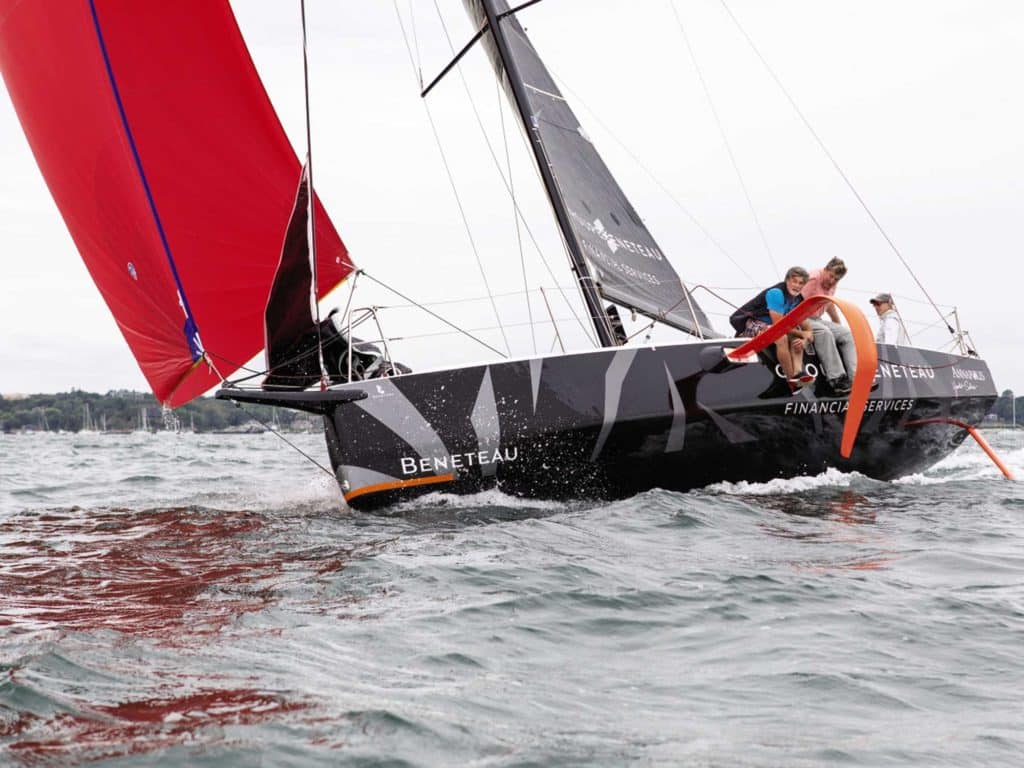
The most efficient foil sections at slow speeds are fatter, with the maximum thickness farther forward, and with larger nose radii, than faster foils. The angle to fluid flow or angle of attack also is greater. We see these slower foils on wings of prop planes and sails when off the wind or in light conditions.
Most sailors are familiar with traditional foils on boats, the teardrop sections of keels that produce lift to weather, reducing leeway, and of rudders, allowing them to steer. Even a flat plate can be a foil, but these tend to be inefficient. Such a shape is prone to fluid separation from the surface, meaning they stall easily, and they maintain poor lift-to-drag ratios. Even keels and rudders are somewhat lift-compromised because they are symmetrical and have to work with fluid coming from either side, whereas lifting foils are more like aircraft wings or propellers, with asymmetrical sections honed for performance in a more stable, fluid flow.
The point is, any foil can be employed at various angles to the surface to prevent leeway, produce increased stability, or help lift the boat out of the water. But those not required to work with fluid flowing from opposite sides can then be honed to maximize lift and minimize drag. Asymmetrical foils were used on boats like Bruce King’s bilgeboarders, including Hawkeye , back in the 1970s. And, designers, including Olin Stephens, had previously employed trim tabs behind keels to improve keel performance.
Sails, which are heeled airfoils, not only drive the boat forward, but they also produce downforce, actually increasing the dynamic displacement of the boat. To counter this and keep the boat sailing more upright, multihull designer Dick Newick first employed slanted asymmetrical hydrofoils in the outer hulls of his small charter trimaran, Lark , in 1962. A portion of the lift developed by the hydrofoil resisted leeway, while a portion worked to actually lift the leeward hull, keeping the boat more upright and reducing dynamic displacement and drag.
Anyone who has ridden on even a foil-stabilized boat will know how riding at least lightly on the waves, and especially above them, beats smashing through them. When boats lift off, everything gets a lot smoother, drag falls away, and the boat accelerates.
Cruising on Foils
But why would a cruiser want to whip over the sea? Wouldn’t this demand an inordinate amount of attention by the crew? Would lifting foils even be applicable to a boat that must have substantial displacement to carry crew and stores? Aren’t cruising-boat hydrofoils an oxymoron?
Maybe, but I believe our boats’ hulls are likely to sprout fins much as fish have as we orient foils to more efficiently resist leeway, add stability, aid steering, reduce drag, increase comfort, allow for shallower draft, and enhance wider variations in hull shapes.
Boats have gotten increasingly wide through the years to advance form stability, improve performance (primarily off the wind), and boost interior volume. But the downside is that fat boats tend to slam more upwind. What if you could reduce dynamic displacement of the boat and lift that hull even partially from the water? The result would be less slamming, especially upwind.
At the same time, what about narrower boats that are known for being more seakindly, especially when closehauled, but lack form stability to carry adequate sail area for powering upwind, and tend to roll badly downwind? Or shallow-draft vessels that are lovely for cruising, but again, tend to suffer from reduced stability? Foils can give that stability back.
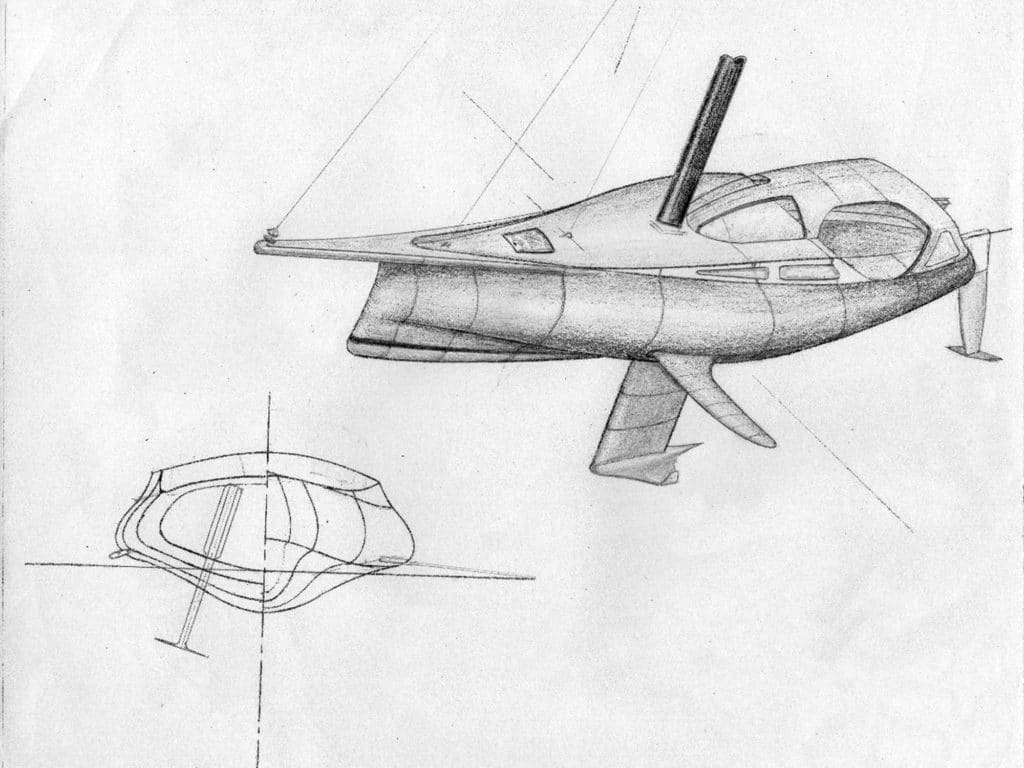
Looking ahead, boat designers might choose to reduce ballast, making up for it with a foil. In short, lifting foils can reduce boat drag and motion while increasing power and performance.
Pitching also does no favors for speed or crew comfort. Foils can come into play here as well. Foils parallel to the sea’s surface resist motion up and down, and a lifted boat skating above chop also is less prone to hobby-horsing through waves. Multihulls have always been particularly susceptible to pitching for a number of reasons, but watching videos of multihulls sailing to weather show an obvious huge advantage that foilers have compared with nonfoilers. Offshore multihulls now routinely employ T-foils on the rudders to control the fore and aft angles of the boat (attitude), a feature easily adaptable to any vessel.
OK, so what’s the cost? Obviously, the more things sticking through the hull, especially if they are retractable, the more it’s going to impact the interior. There would be added weight, complexity and cost. Foils also create noise, and there’s susceptibility to damage from hitting stuff. And let’s not forget compromises with shapes, purposes and things not yet imagined.
As for damage, it’s possible to fold the foils back into the hull. Think swinging center- boards or actual fish fins. Daggerboardlike foils can at least employ shock-absorbing systems similar to the daggerboard arrangements found in many multihulls. This includes weak links that are outside the hull, so if a foil is struck, it frees the foil to fold back or to come off before being destroyed or damaging the hull. Or, foils might hang from the deck rather than penetrating the hull, allowing them to kick up (and to be retrofitted to existing boats). These configurations also relieve the interior of intrusions, and keep the noise more removed from it. I have no doubt that numerous talented designers will be exploring all kinds of options and compromises in coming years, finding ways to make foils both practical and more than worth the compromises.
Sailing more upright, shallower draft, speed, comfort—what’s not to like? Just what is possible? I have a feeling the cruising community is about to find out.
Steven Callahan is a multihull aficionado, boat designer and the author of Adrift , an account of his 76 days spent in a life raft across the Atlantic.
- More: foils , How To , hydrofoils , print june july 2020 , sailboat design
- More How To

Grease the Wheels of Your Boat: A Guide to Proper Lubrication

A Bowsprit Reborn: A DIY Renovation Story

Rigging Redo: Our Switch to Synthetic

Top Tools for Sailboat Cruising: Must-Have Gear for 2024

From Paradise to Medical Emergency: A Bahamas Nightmare Turns Lesson Learned

Free Medical Advice: The Unwarranted, Unprofessional Edition

Gatekeepers of the Waterway

- Digital Edition
- Customer Service
- Privacy Policy
- Terms of Use
- Email Newsletters
- Cruising World
- Sailing World
- Salt Water Sportsman
- Sport Fishing
- Wakeboarding

- Subscribe Now
- Digital Editions

Best hydrofoil boats: 6 of the most spectacular foiling motorboats money can buy
- Electric boats
- Top stories
Foiling technology has really taken off in the past few years. We pick out 6 of the best hydrofoil boats you can buy right now…
With its roots in the 19th century, foiling technology is as old as the hills, but in the past five years we’ve noticed an explosion of hydrofoil boats coming onto the market.
In part inspired by the foiling raceboats of the America’s Cup , the popularity of foiling is easy to understand – fuel efficiency gains are substantial, noise is almost eliminated (particularly if your foiling boat also happens to be an electric boat ) and they look as cool as a snowman in a freezer!
To help you understand the dizzying array of foiling boats available right now, we’ve put together the following guide to what we think are the most promising designs out there.
6 of the best hydrofoil boats

SEAir foiling RIB
Founded in 2016, French yard SEAir builds foiling RIBs, having been inspired by the speed of foiling racing yachts.
We tested their 5.5m model back in 2018 and since then they have expanded their range to cover superyacht chase boats, commercial and military vessels.
Our tester recorded a top speed of 32 knots, with the foils doing their best work at around 20 knots, but SEAir claims that 42 knots is possible in the right conditions.
Read more about the SEAir foiling RIB
Article continues below…

Spirit Yachts launches spectacular long-range electric flying boat
BMW launches new ICON electric boat at Cannes Film Festival
The Cannes Film Festival has seen the launch of the new ICON electric boat. Created by BMW in collaboration with

A dual helm set-up allows the boat to be piloted from the bow or the cockpit. Photo: Guillaume Plisson
Enata Foiler
Dubai-based Enata Marine added a healthy dose of glamour to the world of foiling boats in 2018 with the launch of its Foiler.
In addition to a superyacht tender-worthy exterior, this 32fter includes a bow window for spectacular views while underway.
A 40-knot top speed and a 190nm range makes this a very appealing option, although the premium price tag of $938,000 may put some off.
Read more about the Enata Foiler

Princess R35
When British boatbuilding giant Princess Yachts got in on the foiling boat game in 2019 with a 35ft carbon-fibre dayboat, we knew that things had really taken off.
While the foil-assisted R35 may not have the spectacular cruising-above-the-waves appeal of some other foiling boats, it is highly efficient, beautifully designed (in collaboration with Pininfarina) and handles like nothing else we’ve ever driven.
In our review, we praised its rare combination of agility, refinement and stability, with spray kept in check impressively at high speeds.
Read more about the Princess R35

The foiling Candela C-8 is the first boat to use Candela’s proprietary C-POD, but bigger craft will follow later
Candela C-8
Swedish firm Candela burst onto the scene in 2021 with its debut, the Candela C-7 , which was billed as the world’s first electric foiling boat, but it was the 2022 launch of the Candela C-8 that really moved the game on.
Available with a 69kWh battery, adapted from the Polestar 2 electric car, owners can expect a range of 57nm at 22 knots, more than enough for dayboat use.
The consumption figures are truly staggering, with Candela’s figures suggesting that the C-8 is more than 12x more efficient than an equivalent 300hp outboard powered sportsboat.
Read more about the Candela C-8

The electric Iguana is capable of three knots on the land and 30 knots at sea
Iguana Foiler
Not content with being at the forefront of the amphibious boats market with its caterpillar-track offering, French yard Iguana has set its sights on the world of foiling too.
Announced last year, the Iguana Foiler will be powered by the world’s most powerful electric outboard engine, the 300hp Evoy Storm .
Having tested both the engine and the boat separately, we can’t wait to see the result when they come together with the added advantages of foiling technology. Watch this space…
Read more about the Iguana Foiler

The foils lift up at slow speeds to reduce the draft
Mantaray M24
Another exciting model in the hydrofoil boats pipeline, this 24ft runabout is particularly interesting is its simplicity. Unlike its main foiling rival, the Candela C-7, the Mantaray M24 requires no complicated electronics to ‘fly’.
Instead it uses the builder’s patented mechanical hydrofoil system, which it has trademarked as Dynamic Wing Technology or DWT. The technology is said to be the result of ten years’ development work and uses a retractable T-foil in the bow and H-foil amidships that self-stabilise mechanically.
This allows it to lean naturally into corners and ride serenely over waves without relying on a network of sensors and algorithms to monitor and adjust the foils. If it proves effective this could drastically reduce the cost and complexity of foiling boats, while simultaneously increasing reliability.
Read more about the Mantaray M24
It doesn’t end here, with fascinating one-off projects from Spirit Yachts and BMW on the water, it’s clear that foiling has a huge potential for transforming the world of boating.
Read more about hydrofoil technology
Maserati Tridente: The First Maserati-Branded Motor Boat, and It’s Electric
Witness appeal after reports of a motor boat collision, james bond’s birthday gift to the rnli, latest videos, watch: parker sorrento sea trial: 50-knot cruiser with a killer aft cabin, watch: virtue v10 sea trial: €272k weekender, how to mark your anchor chain: 6 top tips from our expert, watch: galeon 560 fly sea trial – the best galeon flybridge you can buy.
- New Sailboats
- Sailboats 21-30ft
- Sailboats 31-35ft
- Sailboats 36-40ft
- Sailboats Over 40ft
- Sailboats Under 21feet
- used_sailboats
- Apps and Computer Programs
- Communications
- Fishfinders
- Handheld Electronics
- Plotters MFDS Rradar
- Wind, Speed & Depth Instruments
- Anchoring Mooring
- Running Rigging
- Sails Canvas
- Standing Rigging
- Diesel Engines
- Off Grid Energy
- Cleaning Waxing
- DIY Projects
- Repair, Tools & Materials
- Spare Parts
- Tools & Gadgets
- Cabin Comfort
- Ventilation
- Footwear Apparel
- Foul Weather Gear
- Mailport & PS Advisor
- Inside Practical Sailor Blog
- Activate My Web Access
- Reset Password
- Customer Service

- Free Newsletter

Ericson 41 Used Boat Review

Mason 33 Used Boat Review

Beneteau 311, Catalina 310 and Hunter 326 Used Boat Comparison

Maine Cat 41 Used Boat Review

Tips From A First “Sail” on the ICW

Tillerpilot Tips and Safety Cautions

Best Crimpers and Strippers for Fixing Marine Electrical Connectors


Thinking Through a Solar Power Installation

Getting the Most Out of Older Sails

How (Not) to Tie Your Boat to a Dock

Stopping Mainsheet Twist

Working with High-Tech Ropes

Fuel Lift Pump: Easy DIY Diesel Fuel System Diagnostic and Repair

Ensuring Safe Shorepower

Sinking? Check Your Stuffing Box

The Rain Catcher’s Guide

Boat Repairs for the Technically Illiterate

Boat Maintenance for the Technically Illiterate: Part 1

Whats the Best Way to Restore Clear Plastic Windows?

Mastering Precision Drilling: How to Use Drill Guides

Giving Bugs the Big Goodbye

Galley Gadgets for the Cruising Sailor

Those Extras you Don’t Need But Love to Have

UV Clothing: Is It Worth the Hype?

Preparing Yourself for Solo Sailing

How to Select Crew for a Passage or Delivery

Preparing A Boat to Sail Solo

On Watch: This 60-Year-Old Hinckley Pilot 35 is Also a Working…

On Watch: America’s Cup

On Watch: All Eyes on Europe Sail Racing

Dear Readers

Chafe Protection for Dock Lines
Four small boat pvc-foil furlers.
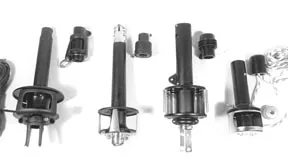
The development of reliable headsail furling must rank high on any list of devices that have significantly changed the way boats are sailed in the past two decades. Hanked-on sails, while having certain advantages, are disappearing in favor of roller furling jibs and genoas. Furlers keep the crew off the bow and reduce time spent sail handling. And thanks to improved designs, the sight of a tattered furling genoa flogging itself to death also is disappearing. Jams, once the bane of furlers, are much less frequent.
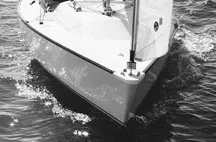
Practical Sailor has tracked the evolution of headsail furling for many years. In 1988 we undertook a comprehensive evaluation of available models and followed that in the May 15 and June 15, 1995 issues with a follow-up evaluation backed by a reader survey, which showed marked improvement in performance, reliability and customer satisfaction. At that time, 77% of all survey respondents said they would buy the same furler again, led by Cruising Design Inc. (CDI) and Famet (an older system) at 100%, followed by Profurl, Schaefer, Harken and Furlex.
In the November 15, 1997 issue, we again updated the group, highlighting the new Hood SeaFurl 5 and redesigned Furlex.
The Small Boat Market Average boat size in the 1995 reader survey was 32′. The number was drawn down a bit by the 25′ average size of boats equipped with CDI Flexible Furlers. Indeed, CDI has made a living selling furlers to owners of smaller boats, especially so-called “trailer sailers.” And while the other major manufacturers, such as Profurl, Harken, Hood, Furlex and Schaefer, have long offered their standard furlers in small boat sizes, and even some simplified models such as Hood’s Line Drive, none tried seriously to compete with CDI’s PVC luff extrusion.
The advantages of the plastic luff are several. First, unlike rigid aluminum luff extrusions, which are shipped in lengths of about 6′, and must be connected with splices or link plates and fasteners, pliable plastic extrusions are one piece and require no assembly. More and more boat owners are buying furlers from mail-order houses and doing the installation themselves. Secondly, the PVC can take a fair amount of abuse and is not as easily dented as rigid aluminum extrusions, an important consideration for any owner when stepping and unstepping the mast. It is of particular concern to owners of trailerable sailboats who handle the mast a lot. Thirdly, cost is less, making furling more affordable for owners of small boats.
Plastic won’t corrode, of course, but is subject to ultraviolet attack. Nevertheless, the addition of UV inhibitors should give them adequate life spans.
Three years ago, CDI’s dominance seemed about to change when Harken announced its first Heli-Foil, which used a PVC luff extrusion with an inner polypropylene sleeve over a braided stainless steel core. There were problems with it, however, and they took a long time to solve. Undaunted, Harken persisted and the new Heli-Foil is now available.
Not to be outdone, Hood Yacht Systems introduced its economical Sea Flex and Schaefer developed its SnapFurl.
We obtained furler kit packages of each, roughly sized for boats up to 24′ with maximum headstay lengths of about 30′ and maximum turnbuckle pin size of about 3/8″. Exact specifications are given in the table on p. 14.
Considerations All four foils come tightly coiled with warnings not to start cutting the bindings willy-nilly. There is a lot of energy packed in these foils that could cause an injury if handled carelessly. Most tell you to make sure the air temperature is at least 70°F and to uncoil outdoors; if it’s colder than 70°F, warm the foil indoors. CDI urges installers to uncoil within 24 hours of receipt so that the foil doesn’t take too much of a set. Observe directions regarding which end of the coil to start cutting free first as there will be a feeder near one end.
While all are flexible, they should be stored flat in the off season (assuming you’ve unstepped the mast). Allowing them to droop deeply also can cause them to take a set. They can be removed and coiled again, but Harken cautions that repeated tight coiling can reduce the life of the foil.
Because PVC is temperature sensitive, the manufacturers warn against exposing the luff extrusion to high heat—around 130°F-140°F. Such temperatures might be found under a boat cover in hot climates.
Presumably to reduce costs, only one of the four offers a line guide attached to the drum; that’s Schaefer and it’s a $23 option. This makes proper placement of the first lead block critical so that the line doesn’t chafe on the cage as it exits the drum.
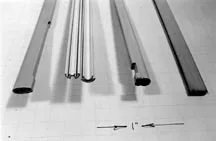
The luff tape sewn to the jib or genoa will be #5 for Harken, Hood and Schaefer, #6 for the CDI Flexible Furler 2.
Ease of furling is affected most by the bearing surfaces, but also by the ratio of the foil diameter to the drum diameter; after all, the difference in the two is what gives you a mechanical advantage. The higher the ratio, the more advantage. We measured all four and developed these approximate ratios: Harken 2.5, Schaefer 2.14, Hood 1.65, and CDI 1.45.
Installation for any system will be easiest with the mast down but because you won’t have to completely remove the headstay for shortening the wire it is possible to do with the mast stepped. Nevertheless, you will have to unfasten the forestay from the stem to slide on the luff extrusion and torque tube/furling drum. Take a halyard forward to a strong attachment on deck, such as a toerail, to hold the mast while you work.
All four systems are fairly simple, with few pieces. The average do-it-yourselfer should be able to install his or her own with basic tools. The one critical job is cutting the luff extrusion to the right length. All manuals give explicit instructions—measure twice, or three times, and cut once.
Halyard restrainers may be necessary with any furler (except CDI with its internal halyard) if the angle of the halyard to the upper swivel is less than about 5°. A restrainer is a simple fitting that is screwed to the mast and through which the halyard is led to increase the angle. This is to prevent “halyard wrap,” in which the length of exposed halyard between the mast and the swivel wraps around the headstay as the sail is furled. You don’t want this!
Compared to larger boat furlers, these—especially the CDI and Sea Flex—are simpler and lack such features as integral adjusters.
CDI Flexible Furler 2 Joe Dahman bought CDI in 1984. At that time, Dahman said CDI was building furlers “on the floor” with metal luff extrusions and plastic links, which had a tendency to break. His first idea was to switch the materials. In the course of investigating and testing plastics, he came upon the idea of making the luff a continuous length, thereby omitting the link plates that trouble nearly every furler. If made of the right material, this single-piece luff extrusion would be much less resistant to damage when raising and lowering the spar, and enable CDI to ship the extrusion coiled in a box. He sold his first Flexible Furler in 1987 and since has delivered more than 10,000. He holds a patent on the flexible luff for which Schaefer is licensed by CDI; Harken and Hood are not.
Price is $515 list, and discounts through Defender Industries (800/628-8225) to about $300.
Unlike most furlers, the CDI uses an internal halyard, which eliminates the halyard swivel at the masthead. This places the furler in compression, not tension, and so the bearing is under less load. The halyard runs up inside one of two opposing grooves in the luff extrusion, through the Halyard Top Fitting, then back down to the head of the sail. The luff is not tensioned by this halyard, however, but by a short length of 1/8″ line seized in two to three parts between the tack of the sail and the downhaul shackle on the spool flange.
The standard furler comes with a UHMW polyethylene bushing as the bearing surface, though an optional bearing race is offered for $70 list. But instead of lots of small bearings, the FF2 model has seven 1/2″ Torlon bearings in a small race. Dahman says that a few large bearings work better and are more reliable than lots of small bearings, which have a greater tendency to get hung up on dirt or other debris in the race. The bearing kit is available as a retrofit; you can do the job in about five minutes.

Dahman has refined the system over the years, adding a few parts here and there. In 1990 a thrust bearing was added and in 1994 he replaced the aluminum cup or cage with stainless steel. For 2000, he enlarged the center hole to accept 5/16″ turnbuckles, crimped a ferrule to the halyard to secure the core to the cover where the line has been decored, and uses a larger 1/4″ braided halyard. Because the 42″ x 40″ coil size of the FF2 requires some straightening of the luff, CDI now offers a 6′ large hoop that is slightly less expensive but costs $60 to ship air freight. It does not require straightening.
There is no stainless feeder, like the Schaefer and Harken, just a slot in the foil, same as the Hood Sea Flex.
The manual with photos and drawings is adequate, if a slight bit confusing to follow at a few points.
The 3/16″ furling line is small to handle; we’d upgrade to1/4″.
In answer to criticisms that plastic luffs twist more than an aluminum luff, Dahman counters that aluminum twists more than people realize, principally at the section links, and that some twist is beneficial in spilling air in gusts.
CDI makes eight sizes of the Flexible Furler, from the FF1 to FF8, which is for maximum headstay lengths of 47′, 5/16″ wire and 1/2″ pin size.
CDI offers a lifetime warranty to the original buyer.
Bottom Line: The least expensive of the four, the Flexible Furler is simple and has a good track record with PS readers. It would be our choice among non-ball bearing models.
Schaefer SnapFurl Schaefer Marine has been making headsail furlers longer than just about any other company, dating to the 1970s when it made simple upper and lower bearing swivels for use with wire luff headsails.
Schaefer entered the modern era with its 1000, 2000, 3000 line in the early 1990s. It has since refined those models and more recently added its SnapFurl small-boat furler. It discounts to about $365.
SnapFurl’s single-groove foil is made of round, extruded PVC in two parts that snap together and interlock, which probably helps it resist twisting. The opposing forces of this joint also help the PVC straighten itself; Schaefer’s Fred Cook nevertheless recommends laying the PVC out in the warm sun for a while before assembly. The foil coils in a 34-1/2″ box.
The torque tube and drum are also injection molded plastic, a “long-grain nylon composite with UV inhibitors.” Bearings are Torlon, with two races in both the head swivel and drum. The two-part cage is stainless steel as is the sail feeder. The fasteners are captive so they won’t fall out if you have to disassemble the feeder.
The six-page manual with drawings is adequate.
Cook said that his company’s intent was to design a furler that was price competitive with CDI but retained some of the features of its other furlers, such as Torlon ball bearings and the ability to fit over the existing turnbuckle. It was also advantageous to use the same foil material as their Tuff Luff racing foil. They also wanted to price the SnapFurl lower than the Harken 00 Heli-Foil. About half of all SnapFurls are sold in Europe—France, England and Germany—Cook said.
Bottom Line: Innovative snap-together foil; stainless cage, feeder and aluminum upper swivel, and ball bearings make this a premium system at a low price.
Harken 00 Heli-Foil The Heli-Foil uses a PVC foil but with a polypropylene interior for what it says is an improved bearing surface. The PVC is cored with braided stainless steel for greater torsional rigidity. Of the four examined, Harken’s looks like it will resist twisting the best. Also, Harken’s foil is the only one of the four that has double grooves; this enables you to hoist a new sail before completely dousing and removing the existing sail.
With racers in mind, the two-part drum also may be removed as well as the halyard swivel, though the latter is probably more trouble than most owners will want to endure (you must rig a temporary headstay and disconnect the turnbuckle).
Discount price is about $700.
The drum is made of plastic while the cage, torque tube and halyard swivel are black anodized aluminum. Double races of Torlon bearings are used in each bearing. A torque tube key locks the foil inside the torque tube. A special clevis pin is required for your turnbuckle, available from Harken when you order your furler. It is longer than your existing clevis pin and locks the lower bearing fork to the turnbuckle and stem fitting.
Like Schaefer, Harken manufactures a complete line of accessory hardware.
Harken’s manual is excellent, with clear step-by-step instructions and accompanying photographs—the best of the group.
Bottom Line: The most expensive of the four, the Harken 00 Heli-Foil is also the most sophisticated with its stainless braid-reinforced PVC foil and aluminum parts; it’s also more versatile, should removing the drum for racing be of interest. Ideal for a J/80 or F/24.
Hood Sea Flex Sea Flex’s one-piece PVC foil is flat, like the CDI Flexible Furler, but has only one slot as it does not employ an internal halyard. It is reinforced with a 1 x 19 stainless wire running its length. This is supposed to help keep the foil from twisting but probably won’t be as effective as Harken’s larger diameter reinforcement.
The torque tube and upper swivel bearing are injection molded parts. The upper bearing has two races of Torlon ball bearings. The lower bearing is simply the stainless steel fork (which attaches to the turnbuckle with a clevis pin) turning inside a Teflon-impregnated Delrin insert in molded grooves in the lower end of the torque tube. Obviously this isn’t going to be as friction-free as one with ball bearings. However, it turned fairly easy…until we assembled the cage.
Like Harken, Hood’s lower bearing fork fits over the turnbuckle so that the clevis pin locks both to the stem fitting. On CDI and Schaefer, the pin simply passes through the slot in the turnbuckle body, which could cause it to unthread if sturdy cotter pins are not used to prevent the studs from turning in the body.
The fork has a second set of holes in case one wants to raise the unit with link plates.
The torque tube is cast in two pieces with threaded brass inserts for the six fasteners. The top and bottom of the drum are also black plastic and snap into grooves in the torque tube. They are easily removable for racing. The cage looks just like those on the SeaFurl 5; it is stainless steel. Assembly is quick, intuitive and actually quite clever.
The cage is held stationary by two pins snapped into the fork and also fits into grooves in the top and bottom cage parts. Thus, the plastic top and bottom cage parts revolve around the stainless, creating what we felt was excessive friction—certainly the most of the four furlers examined. When we queried Hood Yacht Systems’ Mike Haber, he admitted it turns roughly at first, but said that as the system wears in during actual use, there will be no problems furling.
Like the CDI, there is no metal feeder, just a slot cut in the foil.
The 8-page manual has drawings and is adequate.
Bottom Line: Hood Yacht System’s aim was to price the Sea Furl close to the CDI FF2, and it has done that—$311 at discount. While cleverly conceived, friction is a concern.
Conclusion Between the two least expensive—Hood and CDI—the latter has a bushing bearing at the bottom, with optional ball bearings. Hood does not. In addition, CDI’s internal halyard reduces friction. While we like Hood’s clever design, the CDI is a bit less money and has a long track record of customer satisfaction. At least until more experience is gained with the Sea Flex, we’d go with CDI. Owners of the Sea Flex are invited to give us their comments.
Schaefer prices out not much above CDI and Hood. It has just about everything Harken does—ball bearings top and bottom, many stainless parts, and what appears to be a good two-part luff extrusion—at a much lower price. It rates a Best Buy, hands down.
The Harken Heli-Foil is top quality and its split drum and excellent double-groove foil makes it the clear choice for performance sailors.
Contacts- CDI, 100 Cummings Center, Suite 106F, Beverly, MA 01915-3056; 978/922-5936; www.sailcdi.com. Harken Yacht Equipment, 1251 E. Wisconsin Ave., Pewaukee, WI 53072; 262/691-3320; www.harken.com. Hood Yacht Systems, 7712 Cheri Ct., Tampa, FL 33634; 813/885-2182; www.pompanette.com. Schaefer Marine, 158 Duchaine Blvd., New Bedford, MA 02745-1293; 508/995-9511; www.schaefermarine.com
RELATED ARTICLES MORE FROM AUTHOR

Sharing the Cost of Boat Ownership
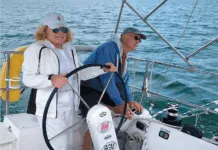
Mailport: Mainsail; Furl Fan; Keel Boats

What’s Involved in Setting Up a Lithium Battery System?
Leave a reply cancel reply.
Log in to leave a comment
Latest Videos

What’s the Best Sailboats for Beginners?

Why Does A Sailboat Keel Fall Off?

The Perfect Family Sailboat! Hunter 27-2 – Boat Review

Pettit EZ-Poxy – How to Paint a Boat
Latest sailboat review.

- Privacy Policy
- Do Not Sell My Personal Information
- Online Account Activation
- Privacy Manager
Foiling 101
The F101 takes you through your foiling journey, providing a progression pathway from the beginner foiler to the Olympian. F101 sets new challenges and goals at whatever level you come in, from expert to beginner.
The F101 is an all-new foiling trimaran aimed specifically at those sailors that, for whatever reason, thought foiling was too difficult for them. The concept originates from the experience of teaching many people to foil in the International Moth class and addressing the main barriers they faced. So we set about creating a new boat without the design restrictions of a box rule – in this way, foiling has been made easier.
“The boats are great fun and I was foiling after about 10 minutes on the first day and having extended periods of foiling after day 2. Not having sailed dinghies for the better part of 20 years, I never really expected to foil, so the boats are fulfilling their designed purpose beautifully. ” — Pete Selby
As an F101 owner, you get access to all of this knowledge and experience, plus access to the F101 Tribe.
The F101 Tribe is an exclusive social media channel that only owners can access, share experiences, tips, and events and generally have a fun time with foiling at the heart of the journey. It is like having a 24/7 help desk..someone, somewhere in the World, is normally awake to help!
The ethos of Foiling World and the F101 TRIBE is to:
· Sail a Fun boat
· Sail with great friends
· Sail in great locations
The F101…more than just a boat! We guarantee to get you foiling, wherever you are in the world, as remote as you like. If you buy an F101, you will FOIL! GUARANTEED!
Whatever your chosen medium, whether it’s a phone, email, text or WhatsApp, we will get back to you!
You can find our phone number and email over on the right-hand side of this page. What are you waiting for?
Few companies give you direct access to this amount of experience, not just before purchasing a boat but throughout your foiling journey.
Got a question? Looking to become an F101 Tribe member? We’d love to hear from you! Contact us .

- FlySafe ® Foil Control
- iFLY Reviews
- Our Partners
- Distributors
Class Association
Enter your keyword.
Just enjoy high speed - foiling
” iFLY – Born to FLY “
Just enjoy foiling, ” high performance sailing “, ” we love speed “, ” join the adventure “.

iFLY15 – Technical SPECS
Length 4.63 m, 15 ft..
A Foiling Catamaran for 1-2 person(s) does not need to be any longer than this. The ancient rule that says you need length to achieve speed does not apply, as hulls do not touch the water at most times.
Width 2.50 m.
This width provides plenty of righting moment, still being road legal ato be transported in horizontal position without disassembly.
7.5 m mast / 11.2 sqm mainsail
7.5 m mast with 11.2 sqm deck-sweeper mainsail. – 8.5 m mast on iFLY RAZZOR Pro with bigger rig
Draft: 95 cm
Weight: 90 kg.
90 kg ready to sail. A very light boat, providing nonetheless excellent stability for everyday suitability.
Crew 1-2 - max.180kg
Flysafe® foil control.
T-Foils Main Foils and Rudders FlySafe automatic dynamic foil control Additional Option: Main Foil Differential >>>
Know More >>>
Different - Rig Options
LATEST DEVELOPMENT OF “DECK SWEEPING” MAINSAIL THE ROLLABLE HERU WING RIG LIGHT WIND FORESAIL «CodeF»
Full Carbon Hulls
Looking for the perfect setup for your foiling sailboat.
We can recommend the best iFLY setup and accessories for your boat. Get in touch for the ultimate sailing experience!
Performance
A great number of innovations all over the catamaran and the perfect match of all components allow controlled high-speed foiling experience. iFLY15 is full of innovations, e.g. in hull design, hydrofoils, rudders, automatic flight control system, two-layer wing trampoline, high performance rig…
HULL Design
full carbon – lightweight – performance design: Born to foil
High Performance Rig Options
LATEST DEVELOPMENT OF “DECK SWEEPING” MAINSAIL WORLD PREMIERE: THE ROLLABLE HERU WING RIG : WORLD PREMIERE: LIGHT WIND FORESAIL «CodeF». ALLOWS UPWIND FOILING (as well as other courses/points) ALREADY IN EXTREMELY LIGHT BREEZE. Know More >>>
Two Layer Trampoline
AERODYNAMIC INNOVATIVE WING TRAMPOLINE CREATING LIFT.
Full Carbon T-Foils
SCIENTIFICALLY DEVELOPED high-end foils for early take off, high speed and maximum stability.
flySafe® dynamic foil control system
The foils are controlled independently, dynamically and precisely on both sides by the flySafe® foil control system . This enables high performance sailing through stable flight. The unique foil control system of IFLY15 is a 7 years proven system developed by CEC Catamarans. Know More >>>
IFLY MAIN FOIL DIFFERENTIAL TECHNOLOGY
MDT FOIL CONTROL – iFLY rake control The sophisticated main foil differential is an active flight assistance – The Rake is adjustable while sailing. Advanced Rake Control is for the experienced, performance-oriented Catamaran sailors / pro sailors and is a feature on the iFLY RAZZOR Pro. Know More >>>
Innovations and more >>>
In the hand of the experienced sailor, iFLY15 is a high-performance racing machine. STABILITY IS NOT CONTRADICTORY TO HIGH PERFORMANCE OR SPORTINESS , on the contrary, it is a prerequisite for safe reaching and maintaining constant high speeds. Stable flight allows the sailor to concentrate on the course, on the wind, as well as on opponents and strategy – rather than permanently getting distracted by working on the foiling balance.
EARLY TAKE OFF IN WINDS AS LOW AS 2Bft. / 6 KNOTS , by combining the innovative “KickOff” foil control with a trampoline that provides boost and with the latest generation of rig and foils.
BOAT SPEEDS FAR BEYOND DOUBLE WIND SPEED CAN BE ACHIEVED . Enjoy high speed foiling with top speeds far beyond 25 knots – in ideal conditions up to 30 knots.
CONTROLLED FOILING EVEN IN THE UPPER WIND RANGE BEYOND 22KNOTS OF WIND SPEED – supported by the new FlySafe® Automatic Foil System.
FOILING PLEASURE AND PERFORMANCE ALSO IN CHOPPY WATERS
FREEDOM ! FLYING SOLO OR OPTIONAL WITH CREW . You have the choice. No manhunt for crew. But still enjoy the opportunity of taking a friend or family to fly with you. Up to 140kg of crew weight. (To keep the boat and especially the mast light, we specified the iFLY15 components intentionally not for double trapeze.)
NO HOISTING AND LOWERING OF DAGGERBOARDS while sailing. (Only for beaching or in shallow waters.)
FREEDOM TO SWITCH BETWEEN FLYING MODE OR SAILING AS A CONVENTIONAL CATAMARAN (with at least the leeward hull touching the water). Within seconds iFLY15 can be switched to Non-Flight mode, even while sailing. In that mode, iFLY15 will not take off, but the foils will still create lift and give an extra agile sailing behavior, which is on the same time very stable as rudder Foils will avoid pitch poling. Non-Flight mode is providing additional security in extreme high wind speeds. It is also useful for less experienced sailors or in all situations, where taking off is undesirable (e.g. in the harbor or while towing…).
EASY TO LEARN FLYING BY AVERAGE SKILLED AND TRAINED SAILORS
EASY BEACHING AND SLIPPING , as simple as with any conventional beach catamaran by using a standard catamaran beach trolley. Foils remain flat under the keel, with the daggerboard lifted as on a conventional catamaran.
SIMPLE TO DISASSEMBLE PLATFORM . Width of 2.50m is also road legal in most countries for horizontal transport without disassembly.
DAGGERBOARDS CAN BE PLUGGED IN FROM ABOVE and Foils securely anchored from below with one central screw.
FAST SET-UP OF THE iFLY15 FROM ROAD TRAILER TO SAILING . Simple rigging the mast, no genacker boom, no foresail, no spi.
SILENT AND CALM PLANING ABOVE THE WAVES . Flight height of up to 90cm, avoiding even high waves below.
EASY TO FOIL THE JIBE (without landing). Stable maneuvers are made easier by the fact that the four T-Foils always remain in the water.
« INTERNATIONAL FORMULA 15 FOIL » Class Association. The new development class for FOILING, SINGLE HANDED on MULTIHULLS. Multi manufacturer class in the tradition of a Formula18, A-Class or international Moth. Enables large regatta fields and evolution of the boats, following the technical progress (which is especially essential in the case in Foiling). Strict regulations to avoid uncontrolled exaggerated development.
Contact : [email protected]
Catamaran Europe Central
The iflysail team, is looking forward to your message, more to know about ifly foiling , interesting tech, high performance rig options >>>, flysafe® dynamic foil control system >>>, ifly main foil differential technology >>>.
MDT FOIL CONTROL – iFLY rake control
News and More
Ifly foiling experience >>>, press articles >>>, events >>>.
NORTH AMERICA'S LARGEST AND MOST ADVANCED DINGHY FACTORY
Country/region
- Australia AUD $
- Austria EUR €
- Belgium EUR €
- Canada CAD $
- Czechia CZK Kč
- Denmark DKK kr.
- Finland EUR €
- France EUR €
- Germany EUR €
- Hong Kong SAR HKD $
- Ireland EUR €
- Israel ILS ₪
- Italy EUR €
- Japan JPY ¥
- Malaysia MYR RM
- Netherlands EUR €
- New Zealand NZD $
- Norway USD $
- Poland PLN zł
- Portugal EUR €
- Singapore SGD $
- South Korea KRW ₩
- Spain EUR €
- Sweden SEK kr
- Switzerland CHF CHF
- United Arab Emirates AED د.إ
- United Kingdom GBP £
- United States USD $

Item added to your cart

fulcrumspeedworks
*NOTE: Sales team will contact you with shipping rates.

WHAT IS IT?
The UFO is a simplistic modern hydrofoiling boat, that allows anyone to fly through the air, freeing the hull from draggy water. More stable than the International Moth -or even a child’s pram- with a simple rig, and a set of fully retractable hydrofoils, all for $11,500 USD the UFO makes flying attainable. Thousands less than it’s nearest competition. Built in the United States in high volume and quality control, the UFO maintains a one-design philosophy, creating close and exciting racing on foils!
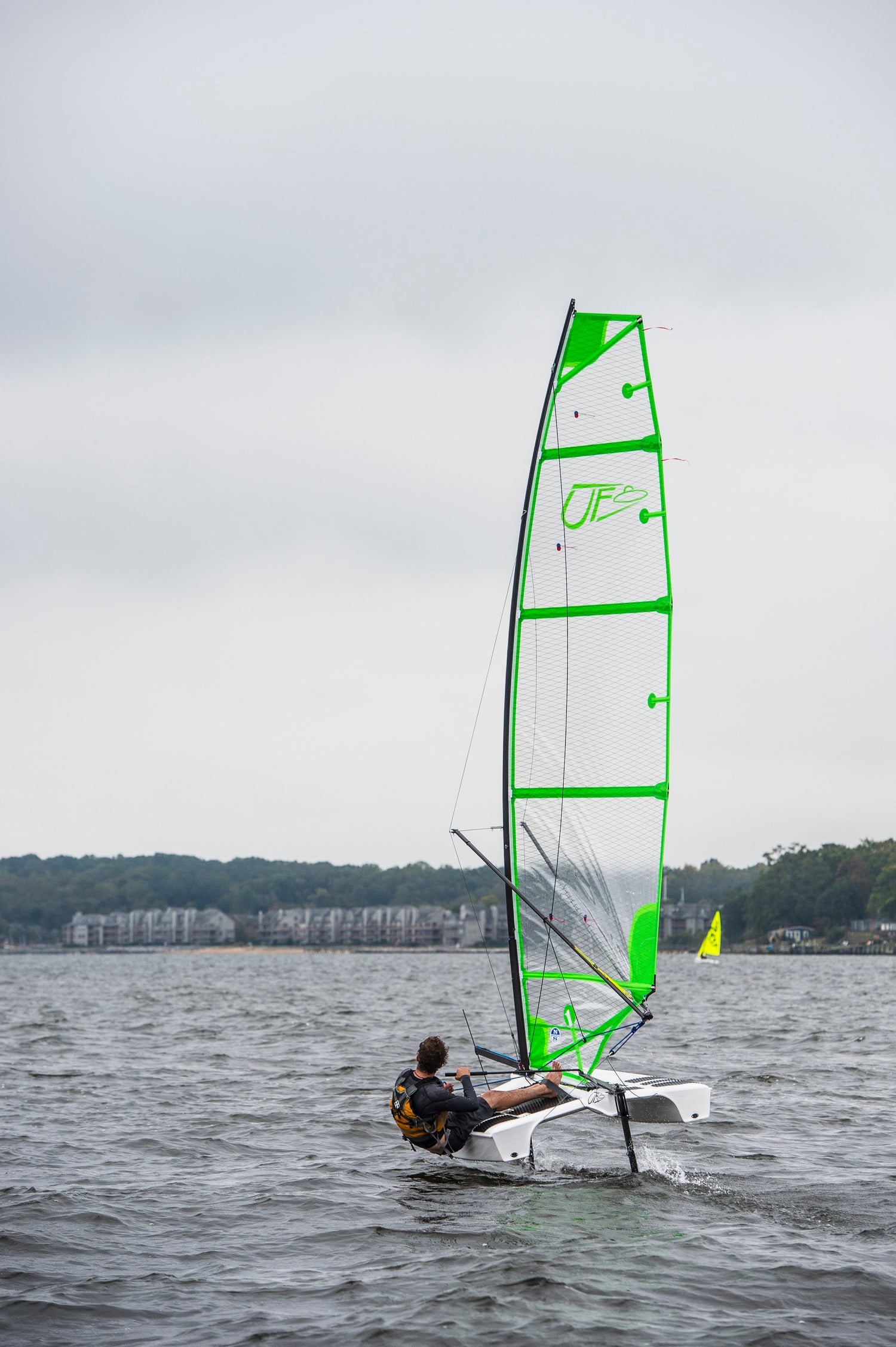
FLY WITH THE UFO
- Designed and built in the USA
- $11,500 USD
- Compatible and rewarding to all skill levels
- Lightweight for easy maneuverability
- Solid, nearly dent-proof, hull
- Unique patented hull and rig designs
- Stable on and above the water
- Small footprint for carefree storage and shipping
- Takeoff from about 8knts of wind
- Fast, fun, easy to control foiling

FUN FOR ALL AGES
The wand system controlling the foils, which can be set to fly very high, very low (even ‘no fly mode’) and all points in between. This means you can progressively add challenges to your UFO experience as you feel ready for them, from ‘beginner mode’ all the way to ‘extreme mode’. Additionally, the highly tunable sail can be set up to provide only the amount of power that your body type needs, and no excess. This means that the UFO is accessible and fun for sailors of all sizes, ages and skill levels. Merely set up the boat for your skill level and body type and go play around.
The UFO is very broadly applicable and has flown payloads from 70 pounds -a tiny kid- to 270 pounds -a tall grown man and a teenage boy-. The foil package just needs power to climb. Ultra light sailors have been caught on camera flying in 5 knots of breeze and the baseline for 225 pound sailors to take off is 10 knots. 270 flies in 12 knots of breeze.
SETUP AND BREAKDOWN
While the boat can be left on shore with everything in place, but the sail down, that doesn’t mean the UFO isn’t easy to put together or take apart. Quite the opposite. Simplicity begets simplicity and the boat is a cinch to put together and take apart.
MANAGEABILITY
Being small is it’s own reward when it comes to handling the boat through all sailing experiences. When you start to really push yourself learning to foil, there are good odds you’ll manage to capsize it. The UFO is easy to right from capsizes and even full “turtle” inversions. This last part is critical, because when catamarans are too heavy to right from turtle the only option is to make the mast float. This has the unintended downside of making the boat very likely to blow away from you. The UFO is designed to stay right alongside you in the event you are separated from the boat. Additionally, the boat possesses an uncommon “park” mode in which it will hold station of its own accord, apparently indefinitely without external input of any kind. The full benefits of that upside have not begun to be fully exploited.

FOILING AT ALL POINT OF SAIL
The Fulcrum design team strictly adhered to the axion “if there’s a point of sail (say, upwind or downwind) that it can’t always foil on, you can’t call it a foiler”. The design team achieved their goal and the UFO is a fully flying boat on all points of sail, which drastically increases its fun-factor.
At what points of sail does the UFO foil at?
The UFO fully foils at all points of sail. Upwind, downwind and reaching. Additionally, you can set it to not foil when you’re tired and it will do that as well, so you can get home easily. These two factors make the UFO uniquely good for learning to foil.
Who can fly the UFO?
Within reason, anyone.
UFO pilots have ranged from 8 years old to 72, from 90 pounds to 235. Young sailors do well sailing as pairs or with a middleweight to light adult. It’s rare that anyone on the fulcrum team conceives of a boat with a narrow niche in mind. Why bother? It’s a mistake in yacht design to design a boat for a narrow range of users, when for the most part people are diverse and the objective of one-design boats is to garner large fleets. That said, the boat is likely to be most satisfactory in all wind conditions in the hands of teens, small and medium men and all women. At the extreme low end of the weight range, sailors may find themselves overpowered and at the extreme high end, the wind speed required for takeoff is about two knots higher than average. UFOs have been sailed “two up” as well, though the above limits of weight range still apply to the sum of the two sailors weights.
What wind and waves can I fly a UFO in?
The UFO will sail in practically any wind condition. However, it’s important to remember that with all sailboats there are days that are great to sail in and days where you do something else.
While the UFO can at times with a skilled skipper take off in very low wind speeds, the baseline for reliable flight is around eight knots. Trying to squeeze enough power to fly out of too little wind is tiresome and in those circumstances, it’s best to do something else. In 8 knots and above, flying is magical and unforgettable. In under 8 knots, the UFO reverts to being a pleasant displacement catamaran and goes from being exciting and fast to relaxing and tactical. This is another benefit of being a catamaran.
Over the last six years the UFO has proven to be uniquely good at flying safely and consistently in very high windspeeds. In multi-class foiling regattas the UFO has proven to be the only foiler built to date that simply loves high windspeeds. In winds above 22 knots when other foiling boats make for shore, the UFO wants to keep playing. The upper wind limit is more a matter of taste and skill. UFOs have been sailed in 36 knots, but that requires a great deal of skill and focus. The UFO rig having shared DNA with a windsurf rig seems to play a part in the boat’s remarkable ability to get a kick out of big wind. Since the upper wind limit on the UFO is so much higher, this makes the number of optimal days to fly a UFO (if skilled in sailing one) higher per year than with any other production foiling boat.
Most chop and wave conditions present no issue for a UFO set for the days’ conditions. After all, powered hydrofoils were first developed by various leading Navy’s as a means of smoothly flying over challenging sea-states. Choking up the ride height helps the UFO fly smoothly through the bottom of the wave pattern, undeterred. Rolling seas present even less issue, as the UFO will ride along them just like any other. Extremely tight and tall chop can be very annoying, which is not peculiar to the UFO.
Waves do effect baseline windspeeds to achieve takeoff. Imagine getting a plane to take off on a bumpy runway. This is true for all hydrofoil boats. In choppy water, ten to twelve knots can be necessary to achieve fully easy takeoffs. Some UFO sailors use aggressive kinetic techniques to overcome this and take off in choppy water and low wind.
Will I fly my first time out?
Most people do, but bear in mind that flying is a whole new experience and it takes some learning.
Conditions, setup and technique matter and if you use it incorrectly, you are likely to get some degree of incorrect results. That’s the challenge that the UFO is built to address. Over six years on the market and over 500 boats delivered, the UFO has proven to be the best and most reliable platform for ordinary sailors to reliably teach themselves foiling technique on.
What happens when I crash my UFO into something?
You’ll probably do some damage to it.
The UFO is built with durability as a core objective but it’s worth noting that the gulf between “Feather light under engineered ragged-edge high performance craft” and “literally indestructible” is extremely wide. The UFO represents neither of these extremes. Do not attempt your first flight inside a densely packed mooring field. Obstacles only make you better once you’ve mastered the basics.
How easy is it to rig a UFO?
Best in class, vs other foiling boats on the market. With that said, it’s not easier than doing nothing. Doing nothing is very easy! Putting a boat together is worthwhile but obviously involves effort.
The current cartop to launched speed record is roughly 15 minutes. Socket the mast together. Attach the boom and stays in one go. Step the rig. Flip the boat on its side, insert the foils, right the boat, hoist the sail and launch. Complexity is best avoided.
Leaving the UFO on a dock or a beach with the rig in and the foils simply in the “up” position, achieves an ease of daily use on par with any light beach cat. To go foiling all you need to do is hoist the sail with the halyard, clip the sail to the boom and attach the downhaul line and you’re ready to launch. This brings setup and breakdown to a matter of five minutes or less.
How do I launch and land a UFO?
Far far far more easily than any other foiling boat on the market.
Because the UFO is a very small catamaran, while floating the hulls float relatively deep in the water and create lateral resistance, like the hulls on a hobie 16 or hobie wave. This means that it can sail upwind without a daggerboard of any kind in the water. This is not the case with non-catamaran foilers. The rudder is outfitted with a friction brake and a down-halyard to allow its depth to vary and allow steering in shallow water. So from 16 inches of water and beyond, you can sail away from and back to shore reliably.
Because the UFO’s forward foil assembly is located in front of the mast, the UFO can tack and gybe while the forward foil is fully withdrawn from the water. This is unique. It allows the UFO to navigate reliably in the period between launching or landing and flying. The benefits for usability and safety cannot be overstated.
Once you’ve got to deep enough water, lower your foils fully and fly away!
That’s if you’re using a dolly.
If you aren’t using a dolly, the UFO has even more party tricks to show off. Since the foils withdraw to above the waterline of the hull, the hull can be beached or slid up onto a dock float or boat deck without any risk to damaging the foils. The UFO is a boat that’s eager to go sailing.
Can I easily cartop a UFO?
At this hull weight, the boat is very easy to put on top of a car, and its flat bottoms allow it to be strapped down hard with no drama. The other components of the boat collapse down to the point of easily fitting in a standard hatchback.
Where can I store my UFO?
Anywhere you can carry it to. Anywhere it fits.
Behind couches, under beds, under porches, in basements, inside larger boats, chained to apartment fire escapes, hanging in garages. Anywhere it can go that’s convenient for your lifestyle is a good place for it to go.
Why does X look like Y? Surely it would be better to make it like Z.
Just trust us.
If you’ve thought of it, we’ve weighed the pros and cons and its been included or excluded for good reason. Creating a boat that can be produced at an affordable price, for a wide range of sailors with a maximum quantity of accessible performance is an extremely hard target to hit. The UFO meets all of its objectives and does so by blatantly ignoring a few conventions and norms. You simply don’t make an omelet without breaking eggs.
- Choosing a selection results in a full page refresh.
- Opens in a new window.

Home » Blog » Sail » Hydrofoil boats for the rest of us
Hydrofoil boats for the rest of us
By Author Fiona McGlynn
Posted on Last updated: August 18, 2023
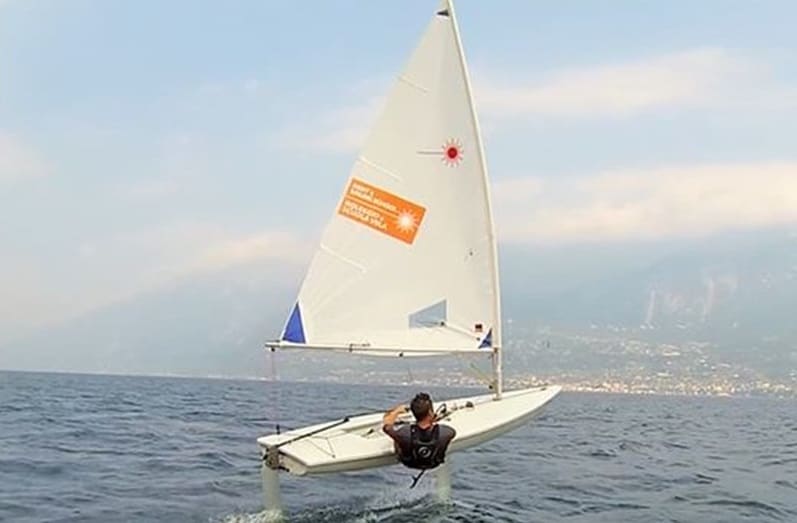
Glide Free Foils Laser on foils. Photo credit: sailboats.co.uk ,
Watching foiling boats fly around the America’s Cup race course, is enough to quicken any sailor’s pulse. But unless you’ve got a spare few million kicking around, most hydrofoil boats are still very much out of the average boater’s budget . There are however a few ways to experience the magic of foiling without racing towards bankruptcy.
HOW DOES HYDROFOILING WORK?
Much in the same way that air flows over and under aircraft wings to create lift, water flowing around a hydrofoil lifts a boat’s hull out of the water . Once the greater part of the boat’s surface area is out of the water, friction is greatly reduced and the boat can “fly” at faster speeds .
How fast? The 2021 America’s Cup AC75s are expected to reach top speeds of 40 to 50 knots!
Like sails, foils are not a matter of “set it and forget it”, instead the foil-attitude must be adjusted to keep the boat in flight . On the 2017 America’s Cup boats these adjustments were made by the skipper/helmsman but powered (via a hydraulic system) by crew grinding winches (or in New Zealand’s case, pedal bikes ).
Because we don’t all have Jimmy Spithill ‘s magic touch, developing highly sophisticated flight control systems is key to bringing foiling into mainstream boating. Candela, a new 25-foot production e-foiling powerboat (and 2019 Best of Boats award winner) offers such a solution with foils that change position 100 times per second! Still, at ~$240,000 it’s well beyond most boating budgets.
Fortunately, smaller foilers (dinghies and boards) don’t require high tech flight control systems and are far less expensive . Here are a few options for (more) affordable foiling:
HYDROFOIL DINGHIES
Laser foiling kits.
Clip a foil onto your Laser and fly over the surface of the water. Two Australian based companies, Foilsz and Glide Free Foils , offer Laser foiling kits. The Glide Free kit doesn’t require any permanent fixtures, so you can easily remove it (for those days when you’re in a displacement mode mood). They say that speeds of 18-25 knots are possible with their kit, which sells for just under $4,530 AUD (~$3,00 USD).
UFO foiling multihull
For a few bucks more you can buy a foiling catamaran. The UFO was launched in 2017 and can fly at 15-20 knots. With a price tag of $7,000, it may be the most economical multihull foiler on the market.
Take a foiling course
Some clubs and community sailing programs are adding foilers to their fleets. For example Nantucket Community Sailing offers a 3-hour semi-private class for $100 per person . Or if you’re looking for a more exotic locale, the Provela Foiling Centre in Spain offers a range of foiling classes from beginner to advanced. Their two-day “Try Fly – Foiling” class costs 200 euros and their fleet includes Foiling Moths, White Formula Whispers, WASPZs, and F101s.
HYDROFOIL KITEBOARDS
It’s not like kiteboards are sluggish to begin with, but hydrofoil boards take the sport to a whole new level, delivering speeds of 40 miles an hour ! By using a foil to lift their boards out of the water, foiling kiteboard enthusiasts get an exceptionally quiet and smooth ride – so much so, that kiteboard riders in Silicon Valley have been spotted taking calls on their cell phones. Set up costs start at around $1,000. Take a foil boarding course and buy protective gear, this extreme water sport is not for the faint of heart.
HYDROFOIL WINDSURF BOARDS
Foiling is taking off in the windsurfing world with world champions like Robby Naish and Atoine Albeau leading the charge. It has been confirmed that windfoiling will be a class at the 2024 Olympics in Paris . Set up costs start around $2,500.
With foiling technology trickling down into the mainstream, you can expect to see more and more high speed foiling boats and boards on the water . Is foiling the future? Let us know what you think in the comments below.
Fiona McGlynn is an award-winning boating writer who created Waterborne as a place to learn about living aboard and traveling the world by sailboat. She has written for boating magazines including BoatUS, SAIL, Cruising World, and Good Old Boat. She’s also a contributing editor at Good Old Boat and BoatUS Magazine. In 2017, Fiona and her husband completed a 3-year, 13,000-mile voyage from Vancouver to Mexico to Australia on their 35-foot sailboat.
Terms and Conditions - Privacy Policy
- {{>productsMenu}} Products
- {{>trendsMenu}} News & Trends
- Sailing >
- Monohull sailboats >
- Foiling sailboat
Foiling sailboats
- My filters foiling Delete all
Manufacturers
- ABSOLUTE DREAMER (1)
- Befoil (1)
- Black Pepper Yachts (1)
- Design Catamaran Inc (1)
- Farrier Marine (NZ) (3)
- Flying Mantis (1)
- Foiling World (1)
- McConaghy (1)
- Nautor Swan (1)
- Quant Boats (3)
- SL Performance (2)
Number of hulls
- multihull (10) trimaran catamaran
- monohull (6)
Intended use
- racing (13) one-design coastal racing ocean racing
- cruising-racing (3)
- daysailer (2)
- classic (1)
- sport keelboat (1)
- cruising (1) fast cruising coastal cruising
Overall length
Displacement, motor power, fuel capacity, number of cabins.
- 1-cabin (3)
- 3-cabin (1)
Maximum berth number
- 4-berth (1)
- 6-berth (1)
- 8-berth (1)
- foiling (16)
- fixed keel (2)
- twin rudders (1)
- dinghy-type (1)
- lifting keel (1)
- with bowsprit (3)
- carbon mast (3)
Other characteristics
- semi-custom (2)
- with ballast (1)
- folding arms (1)
- sail-drive (1)
- transportable (1)
- twin steering wheels (1)
& reach your clients in one place, all year round
{{product.productLabel}} {{product.model}}
{{#each product.specData:i}} {{name}} : {{value}} {{#i!=(product.specData.length-1)}} {{/end}} {{/each}}
{{{product.idpText}}}
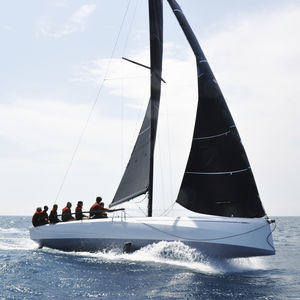
racing sailboat ClubSwan 36
Overall length : 11 m Width : 3.6 m Draft : 2.75 m
The fortune of Nautor’s Swan was born with a 36 footer, one of the first few yachts built in fiber-glass. When the Swan 36 arrived on the scene a new datum was set. With her combination of fast lines, incorporating the modern separated ...

racing sailboat AC40
Overall length : 11.8 m Width : 3.38 m Draft : 3.5 m
Presenting the AC40, a scaled AC75 foiling day-racer designed by Emirates Team New Zealand and built by McConaghy. A one-design class that brings America's Cup foiling performance to a competitive ...
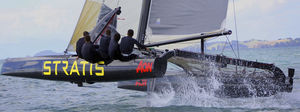
catamaran SL 33
Overall length : 12.6 m
Main advantages of the SL 33 one design! Excellently well tested, we are foiling for nearly 2 years together with ETNZ and Luna Rossa Our foils come directly out of the AC Lowest possible weigth, built out ot prepregs ...
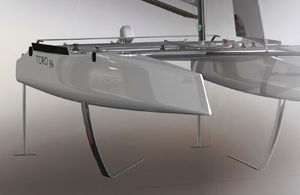
catamaran TORO 34R
Overall length : 10.4 m
Our original TORO34 flirts easily with 25kts and more off the wind… How could we make the Toro to blow 30kts? Design Catamaran is in the final stages of releasing the TORO34R, equipped with foils, a 6.1m (20’) beam and a 15.9m (52’) mast. ...

foiling sailboat
Overall length : 4.2 m Width : 2.4 m Sail area : 11 m²
AWARD WINNING BOAT THAT’S TWICE THE FUN Airborne foiling or sailing with a daggerboard. Foiling is a sport that is here to stay. Foiling has been around for years but until now it ...
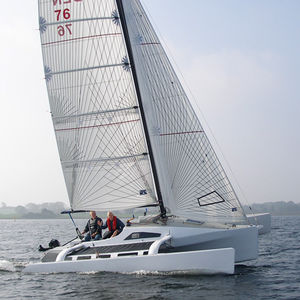
trimaran F-22
Overall length : 7 m
The F-22 is a new design that has been developed in New Zealand by Farrier Marine (NZ) Ltd. The production F-22 is now available and is being built in the United States. The F-22 was initially available in plan form for those who wished ...
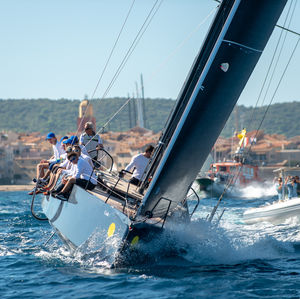
fast cruising sailboat Code 1
Overall length : 12 m Width : 13'00" Draft : 4'01", 9'09"
This magnificent Vintage style, 40-foot yacht, cruising-racing boat built entirely in carbon, with the help of the best French specialists is testament to Black Pepper’s® commitment to “Luxury” and “French Art de vivre”. A purely exceptional ...

catamaran Befoil 16 CARBON
Overall length : 5 m
The Befoil 16 CARBON is a foiling catamaran that offering speed and accessibility. Designed and assembled in France, our high-tech carbon sailboat combines lightweight, aesthetics, stability and performance. We ...

foiling sailboat F101
Overall length : 5.4 m Width : 2.55 m Sail area : 9 m²
Foiling World started gathering experience about dinghy foiling 10 years ago when Alan started teaching foiling on International Moths. It soon became apparent that Moths were not the ...
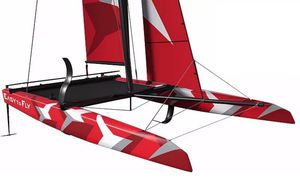
Overall length : 8.1 m
Technical characteristics Hull length with rudders Beam Mast height Draught Carbon epoxy S-Foils Weight of craft Architect / Design plans Builder Hull Graphics Project 8.10 m/26.6 ft. 4.30 m/14.10’ 13.70 m/44” 1.20 m/3.93’ 325 ...
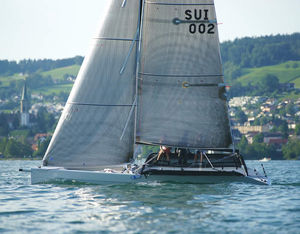
racing sailboat Q30
Overall length : 9.15 m
The new Q30 is closely related to and a further development of the pre-series DSS boat Q28. The Q30 combines unparalleled performance with easier handling on the water, as well as during boat preparation and transportation. The Q30 is ...
Your suggestions for improvement:
Please specify:
Help us improve:
Receive regular updates on this section.
Please refer to our Privacy Policy for details on how NauticExpo processes your personal data.
- Sailing yachts
- Sailing super-yachts
- Foiling sport catamarans
- Foiling sailing dinghies
- Marine upholstery fabrics
- Manufacturer account
- Buyer account
- Our services
- Newsletter subscription
- AboutVirtualExpo Group
672 Wine Club
- Motorcycles
- Car of the Month
- Destinations
- Men’s Fashion
- Watch Collector
- Art & Collectibles
- Vacation Homes
- Celebrity Homes
- New Construction
- Home Design
- Electronics
- Fine Dining
- Benchmark Wines
- Brian Fox Art
- Chase United
- Disneyland Resort
- Gateway Bronco
- Royal Salute
- Sports & Leisure
- Health & Wellness
- Best of the Best
- The Ultimate Gift Guide
6 Electric Surfboards That’ll Help You Ride the New E-Foil Wave
Our top six picks of the latest offerings from names like fliteboard, lift and aerofoils are designed for all rider types., j. george gorant, j. george gorant's most recent stories.
- Electric Air Taxis Are Poised to Help L.A. Transport Fans During the 2028 Olympics
- Paris Airports Have Undergone Major Overhauls Ahead of the Olympics
- The Space Tourism Race Is Heating Up—Here’s Everything You Need to Know
- Share This Article

Electric surfboards, the fastest-growing segment of yacht toys, make it possible to carve waves in even the flattest conditions. Most foil-less e-boards don’t really look much like a surfboard, but still deliver a fast-running, sharp-turning surfing experience, thanks to compact electric motors and electronic hand controls. The recent explosion of e-foil designs, from oversized models with handlebars for beginners to sleek, low-volume boards for advanced riders, means there’s a board for every enthusiast. Plus, foils deliver advantages. “Hydrofoils need less power and lighter batteries, so they extend run times,” notes David Trewern, founder of Fliteboard, one of the original e-board manufacturers. “It’s hard to beat that feeling of riding above the water.” A dozen competitors are looking to carve up their own slice of the market with feature-rich models for beginners to elite riders alike. Here are six of the big kahunas.
Fliteboard MN86

Stylish, sturdy, and technical, the limited-edition Marc Newson Design series from Fliteboard is the ultimate e-foil for riders who want a beautiful stealth look and exceptional foiling. The pictured MN86 has a generous 5’4” x 26” footprint for riders that crave stability, while its sleeker sister boards, the MN60 and MN60 Wave, deliver faster speeds and tighter turns. All incorporate a monobloc design with advanced, high-modulus pre-preg (HMPP) construction that ultimately results in a lightweight, stiff ride. Its titanium conical wings are designed for minimal drag. The series, which will be limited to 999 examples, offer different wing options for varying conditions and an interactive color display on the hand controller that delivers data from every session. This e-foil lifts cool tech to a new level. From $19,995
Awake Vinga 3 SR

The super-stable Vinga 3 SR, with its high volume and double-concave bottom, offers easy starts, low-speed planing, and forgiveness for mistakes. The 3 SR has a top speed of 31 mph for fast carving, with a riding time of up to two hours for exploration. Its deck is covered with a soft-grip pad for comfort while offering secure footing for the rider. Awake designed this as the beginners’ board to build skills for advanced e-foiling. From $13,900
Audi e-tron efoil Performance

Aerofoils’ collaboration with Audi finds the automaker’s e-tron aesthetics integrated into a board that, with its tight turning radius, shares the marque’s penchant for agility. The pictured Performance model is just what it sounds like, offering advanced riders knife-like turning, fun in the surf and a top speed of 34.2 mph. The e-drive is integrated into the fuselage and pushes the wing directly, which Aerofoils says creates more stability and the potential for tighter curves. The e-foil also has up to two hours of battery life. From about $17,300
Lift4 Sport

Lift’s new 57-inch-long, all-carbon-fiber Sport has sound-dampening technology and new wings—with multiple wing options for fast cruising or razor-sharp carving—that enhance stability at higher speeds. The add-on Blowfish attachment is an inflatable collar that goes around the edge of the Sport, offering even more stability or the ability to cruise seated, like a small boat. The Lift4 series also includes a 50-inch Pro model for advanced riders. From $12,995

The E is the largest board in SiFly’s range, designed for beginners and heavier riders. But the design team didn’t skimp on style or a safe-but-thrilling ride. Its 6’3” length delivers stability, while its 28-mph top end is fast, but not scary fast. Battery life is two hours, while charging time is 2.5 hours. The E has two mast lengths and three wings that dial in stability and speed for specific owners in different conditions. From about $7,800
LIND Canvas

Swedish newcomer LIND has reimagined the electric surfboard, sans foils, in a classic California style. Available in a shortboard or mid-length for different abilities, the Canvas is beautiful and lightweight, featuring modular construction that doesn’t require tools. It’s about as close to surfing as you can get without waves. The board weighs just 15 lbs., and the battery and jet can be carried separately in a custom backpack. The Canvas also features a compact, powerful and lightweight powertrain that delivers a top end of 37.2 mph. The craftsmanship on this board is exceptional. From $24,950
Read More On:
More marine.

New Zealand’s Thrilling Win Gets the America’s Cup Off to a Rip-Roaring Start

This Revamped 161-Foot Trinity Superyacht Could Be Yours for $16 Million

Rescuers Find Remaining Missing Aboard the Sunken ‘Bayesian’ Superyacht

Tech Mogul Mike Lynch and 5 Others Are Missing After a Yacht Sinks in Italy

Meet the Wine Club That Thinks Differently.
Receive editor-curated reds from boutique California producers four times a year.
Give the Gift of Luxury
Latest Galleries in Marine

10 Must-Haves That Will Make Your Yacht Trip Even Better
More from our brands, jeremy allen white and calvin klein reunite for fall 2024 in americana-inspired underwear and denim campaign, wells fargo hires sports banking exec peter dorfman from truist, sag-aftra wins passage of california bill to limit ai replicas, christie’s will celebrate birth centenary of francis newton souza with non-selling exhibition, the best yoga mats for any practice, according to instructors.

IMAGES
COMMENTS
10. New Zealand 'R' Class skiff. In New Zealand they love their skiff sailing, and development classes like the doublehanded 'R' Class are prime for new features. The 'R' Class started its project to get the fleet foiling back in 2008 and now there are a clutch of boats racing.
Subscribe now for $29.99 a year and have immediate access to all of our content, including hundreds of small-boat profiles, gear reviews and techniques, adventure stories, and more! You can also browse our entire archive of back issues starting from September 2014, as well as post unlimited classified ads. This is an extraordinary value! We ...
At A Glance. Price As Sailed: $24,750. Design Purpose: Learn to foil, advance skills. Crew List: One or two. Rob Andrews and his business partner Alan Hillman have been teaching foiling for a ...
#Foiling #Sailing #WinterBoatingLike the look of the new America's Cup foiling boats? Find out here how foiling boats work and how you could start foiling in...
HD-4 used three 'ladders' of small foils, one at the front, and one each side close to the back. ... These angles close as the boat sails and the foil is loaded up to become much closer to, or ...
Catalina 16.5. jlodrummer. Catalina Yachts are synonymous with bigger boats but they have some great and smaller boats too such as Catalina 16.5. This is one of the best small sailboats that are ideal for family outings given that it has a big and roomy cockpit, as well as a large storage locker.
Technical details. The F1x A-class foiling catamaran has a number of unique features that improve performance. For example: Semi ridged trampoline. Gives extra torsional stiffness to the boat and increases its aerodynamic characteristics. Patented main-sheet-wheel-system. For more direct and faster trim of the main sail.
The flight control system, combined with numerous fine-tuned innovations, ensures safe foiling even in strong winds and rough seas.. Stable flight attitude allows pushing hard, so in good conditions, iFLY reaches high boat speed beyond 30 knots in a controllable way. IFLY15 offers freedom to fly alone or in pairs.
The TF10 is an 11 m long one-design foiling trimaran, designed by the famous yacht designers Morrelli & Melvin. The TF10 is built and sold by DNA Performance Sailing. The TF10 is suitable for a crew of 4-5 persons and can handle a wide range of sailing conditions. The construction consists of pre-preg carbon fibers with a Nomex honeycomb core.
Length 5.4m. Beam 2.55m. Sail area: 9.0m2 main + 5.5m2 gennaker. Target crew weight range: 60-150 kg. Take off wind speed: 7 kts. Boat speed range: 10-25 kts. Please visit Foiling World at www.foiling101.com for more information. F101 All-inclusive, Ready to Sail package includes: Epoxy Carbon hull platform.
Then friction only acts on the small foils, not on the whole hull, which is why a 130-foot hydrofoiling sailboat can "fly" at over 50 knots. Powerboats have added friction from the propulsion system that has to remain in the water, but even then, large hydrofoiling ferries can exceed 45 knots. Speed is not the only advantage that hydrofoils ...
Shortly after her re-launch at Easter, it was clear that the team had raised the game. "We can now foil upwind in just 8 knots of breeze," said Monnin. "And when the breeze builds to 12 ...
A standard horizontal DSS foil, by comparison, represents only a small fraction of a boat's total price tag, and according to Welbourn's partner, Gordon Kay, who runs Infiniti Yachts, is effectively cost-neutral, because the extra righting moment created by the foil leads to savings in construction expenses, since the boat itself can be ...
Italian Enrico Forlanini began experimenting with foils in 1898. In 1906, his 1-ton 60 hp foiler reached 42.5 mph. Alexander Graham Bell's HD-4 Hydrodrome flew on Bras d' Or Lake at 70 mph in 1919. And several sailing foiler patents began appearing in the 1950s. Notably, JG Baker's 26-foot monohull, Monitor, flew at 30-plus mph in 1955.
Enata Foiler. Dubai-based Enata Marine added a healthy dose of glamour to the world of foiling boats in 2018 with the launch of its Foiler. In addition to a superyacht tender-worthy exterior, this 32fter includes a bow window for spectacular views while underway. A 40-knot top speed and a 190nm range makes this a very appealing option, although ...
The Small Boat Market Average boat size in the 1995 reader survey was 32′. The number was drawn down a bit by the 25′ average size of boats equipped with CDI Flexible Furlers. Indeed, CDI has made a living selling furlers to owners of smaller boats, especially so-called "trailer sailers."
Foiling 101. The F101 takes you through your foiling journey, providing a progression pathway from the beginner foiler to the Olympian. F101 sets new challenges and goals at whatever level you come in, from expert to beginner. The F101 is an all-new foiling trimaran aimed specifically at those sailors that, for whatever reason, thought foiling ...
We can recommend the best iFLY setup and accessories for your boat. A great number of innovations all over the catamaran and the perfect match of all components allow controlled high-speed foiling experience. iFLY15 is full of innovations, e.g. in hull design, hydrofoils, rudders, automatic flight control system, two-layer wing trampoline, high ...
Sailboats with foils: the evolution seen by Sirena, Soldini and Pedote. To understand the evolution of foil sailboats we interviewed Max Sirena, Giovanni Soldini and Giancarlo Pedote.
FLY WITH THE UFO. Designed and built in the USA. $11,500 USD. Compatible and rewarding to all skill levels. Lightweight for easy maneuverability. Solid, nearly dent-proof, hull. Unique patented hull and rig designs. Stable on and above the water. Small footprint for carefree storage and shipping.
Candela, a new 25-foot production e-foiling powerboat (and 2019 Best of Boats award winner) offers such a solution with foils that change position 100 times per second! Still, at ~$240,000 it's well beyond most boating budgets. Fortunately, smaller foilers (dinghies and boards) don't require high tech flight control systems and are far less ...
Jul 22, 2024. Original: Nov 30, 2018. With the TF10, big-boat multihull foiling is now available to amateurs as well as pros. Any time I put a helmet on I become hyper-aware of every step I take. Precaution means there's an alternative to a happy ending. On one of my last rides of the 2018 summer season, the helmet was mandatory, as was the ...
racing sailboat ClubSwan 36. foiling with bowsprit carbon mast. Contact. Overall length: 11 m. Width: 3.6 m. Draft: 2.75 m. The fortune of Nautor's Swan was born with a 36 footer, one of the first few yachts built in fiber-glass. When the Swan 36 arrived on the scene a new datum was set. With her combination of fast lines, incorporating the ...
The e-foil also has up to two hours of battery life. From about $17,300. ... like a small boat. The Lift4 series also includes a 50-inch Pro model for advanced riders. ...